- Newsletter Issue Number:
- AICCM National Newsletter No 157 April 2022
The AICCM wishes to advise Aboriginal and Torres Strait Islander readers that the following article contains the name of person who has died
National Gallery of Australia
The Conservation Department at the National Gallery of Australia is in for a busy year preparing for the Gallery’s 40th birthday celebration. So far this year there has been a major focus on the collection, redevelopment of displays, and lending. The Conservation Department has been reworking the loan assessment process with a greater focus on environmental disasters, now including fire/smoke and flooding into the process. The position of Conservation Loans and Exhibitions Coordinator has just been advertised.
Objects Conservation is busy working on a number of concurrent projects. The whole team has been involved in installing NIAT V: Ceremony: condition checking and installing works of art with visiting artists, including Robert Andrew’s writing machine and Penny Evans’ Burnt Banksia “Gudhuwu-li”. Courtney Crane has been working on the forthcoming exhibition of Robert Rauschenberg and Jasper Johns works from the Ken Tyler collection, which will go on display inhouse in June and then will travel to various venues throughout Australia. Kim Goldsmith is testing fills, adhesives, and paint materials of polystyrene (EPS) collection objects and condition reporting and preparing travelling art cases. These cases include new acquisitions and themes that showcase a wider range of female and First Nations artist’s work. Yayoi Kusama’s work Descended into the Heavens has travelled to the Art Gallery of South Australia and Jack Dallwitz has overseen the complex installation.
Paper Conservation and Mountcutting have been preparing works for the rehang of International Art and Ever Present, a travelling exhibition of Aboriginal and Torres Strait Islander works travelling to the National Gallery of Singapore. Paper Conservation has also been preparing works for Rauschenberg and Johns, which includes large cardboard sculptures and paper-pulp works, and requires working with exhibition designers Mountcutting and Fini Frames in Melbourne to develop double-sided frames.
Paintings Conservation has been busy condition checking and treating paintings to be included in Ceremony. Jocelyn Evans has recently completed a treatment of a still life by Ethel Carrick, which involved many hours spent removing a particularly insoluble varnish layer.
Micheline Ford, Carmela Mollica and Michelle Hunter have been treating several silk batik textiles included in the Ever Present exhibition, as well as several small changeovers within the Gallery. Textiles Assistant Tiffany Abbott has done a fantastic job dyeing display mechanisms to match as they will be seen on display suspended from the ceiling. Melissa Bolin is working with the department two days per week, condition reporting and treating 23 soft sculptures in Ceremony. Carmela Mollica continues to oversee the complex care of the Skywhale and Skypapa hot air balloons while they are on their tour of Australia, and has seen many a sunrise around the country.
National Library of Australia (NLA)
After working alternate weeks onsite since November, 28 February marked the first day back to fulltime onsite work for our team. This momentous moment was celebrated with a big morning tea filled with lots of cake.
Since being back onsite our team has been making up for lost time, working across a wide range of activities including preparing outgoing loans and materials for digitisation, opening new exhibitions and contributing to stack relocation projects.
One of the most notable projects, which we have been carefully planning over the past two years, came to fruition in February, with the temporary removal of our three large Matégot tapestries (which are usually on permanent display in the Library foyer). The tapestries are away receiving freezer pest treatment, to be followed by surface cleaning, various repairs and replacement of the Velcro used to suspend them from the walls.
Whilst the tapestries are away, they have been replaced by incredibly detailed facsimiles. It is hard to spot the difference between these and the originals.
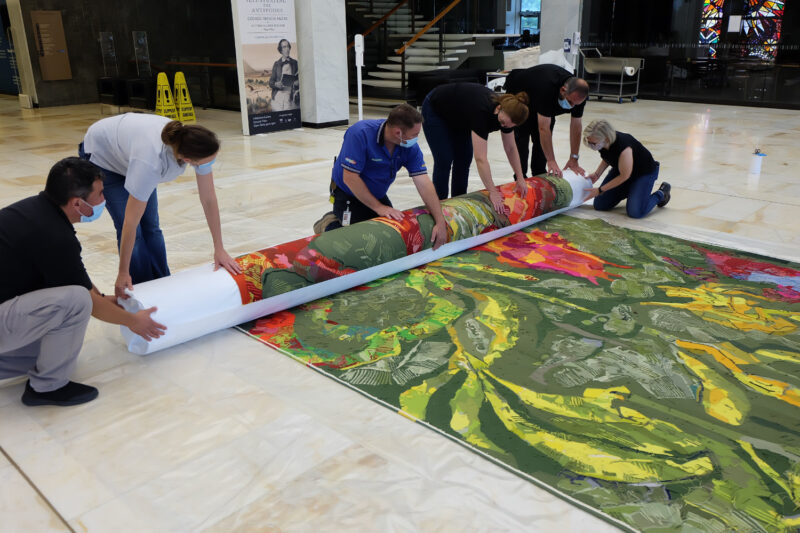
ICS and NLA staff rolling the Land of the Parrot Matégot tapestry for transport.
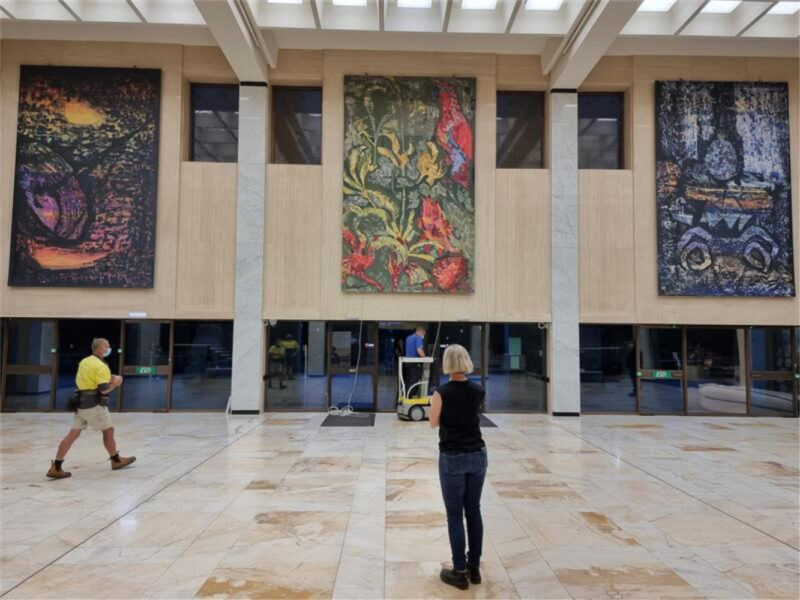
Tania Riviere, Director of Collection Care, observing the newly installed facsimiles of the Matégot tapestries.
Staffing
In February, Collection Care said a temporary bon voyage to Lisa Jeong-Reuss as she took up an opportunity with the National Museum of Australia for a six-month transfer, managing the Paper and Textile Conservation Lab. Lisa’s Preventive Conservation Manager position has been filled by Cheryl Jackson, and Jennifer Todd is backfilling Cheryl Jackson’s APS5 Senior Conservator role.
The team also warmly welcomed Alex Genetzakis in an ongoing position as APS4 Collection Officer and in March Nicole Rowney also joined the team as Conservation Contractor working on the Preservation for Digitisation program.
Art Gallery of NSW (AGNSW)
The Conservation department at AGNSW was delighted to hear that Paper Conservation volunteer Marsha Swensom was announced as recipient of the prestigious AICCM Conservation Volunteer of the Year Award in Dec 2021. Marsha has been working as a volunteer at the Gallery for over 30 years in various capacities including Asian Programs and the Task Force but has for the past 18 years been working weekly with the Conservation team. Marsha is a great example of the value volunteers bring to cultural institutions and we are most grateful to AICCM for recognising the contribution of volunteers across Australia.
As our team prepares for a very busy year, we are excited to welcome new staff: Juanita Kelly Mundine (ATSI conservator); Emily Vearing, paintings conservator; Ashley Gilmour, objects conservator; Grant Hawkes, technical assistant in Mountcutting; and Ziggy Potts, technical assistant in Digital Preservation. The department is currently focused on a mid-year rehang of the 20th Century and Asian galleries in our existing building, as well as preparations for the opening of new exhibition spaces in our Sydney Modern galleries. Light exposure has been a particularly important consideration department-wide, as we become familiar with exciting new gallery spaces and modifications to existing architecture.
Time-Based Art (TBA) Conservation
The TBA Conservation department has been busy undertaking artwork testing and coordinating treatments for works that will go on display as part of the Sydney Modern Project or the current Gallery rehang, while also undertaking necessary collection maintenance to improve access to and visibility of the TBA collection. Lisa Mansfield has most recently been working closely with Audio Visual staff to set-up Hiraki Sawa’s video installation work Lineament to assess preservation requirements for integral software, while Jonathan Dennis has been working with ICT staff to test Paul Chan’s computer-generated video projection 1st Light to assess the functionality of equipment at risk of obsolescence. Rebecca Barnott-Clement has been working closely with the Digital Preservation team in recent months to streamline digitisation, digital preservation and digital asset management workflows as part of an inventory of the TBA Collection (2022–2023) and to support the ingestion of viewing copies of all TBA Collection works into Fotoware.
Digital Preservation
The Digital Preservation team welcomed Ziggy Potts to the role of Digital Preservation Technical Assistant. Ziggy comes to us from MAAS and has been working with the TBA Conservation department on the consolidation of its digital collections. Jo Fleming has been working on drafting a metadata framework and dictionary for corporate and collection files. This dictionary will inform all of our metadata needs both internally and externally and inform our access and digital preservation programs. The digital preservation system and storage Expression of Interest has gone to market and the results will help the Gallery determine the type of system and storage it wants to implement over the coming months.
Paper Conservation & Mountcutting
In Paper Conservation, Analiese Treacy and Sarah Bunn have been processing some major gifts to the Gallery including a significant number of 17th–20th century Indian paintings on paper and mid-20th century photographs from across Asia, many of which will be included in the upcoming rehang of the Asian galleries. Treatment of two large Indian folk paintings on paper has begun, with custom frames being made by Tom Langlands for the rehang of the Asian galleries. Lois Waters has been focused on preparations for the 20th Century galleries rehang, with major treatments including a backing removal on a graphite drawing by Thea Proctor, as well as repairs and consolidation of a series of David McDiarmid collages. Grant Hawkes has been busy working on mounting projects across all exhibitions, including the preparation of a series of acrylic paintings on handmade paper by Sheroanawe Hakihiiwe for the Sydney Biennale, and preparing over 90 works for the upcoming Young Archies exhibition. Julia Bavyka recently finished a phase box making project for 22 sketchbooks and picture albums from the AGNSW collection. They are currently working on a Foundation Presentation folder project to accommodate prints commissioned by Richard Lewer.
Paintings Conservation
The Paintings team’s focus has been on the 20th Century galleries rehang. Over 250 paintings were assessed and treated when necessary by Celine de Courlon, Madeleine Ewing, Emily Vearing, Juanita Kelly-Mundine and Sophie P d’Abrigeon. The Australian 20th century galleries on the ground floor of the Gallery were deinstalled in mid-February, giving the opportunity to assess and dust all the paintings that were on display before they were taken to storage by the Installation and Registration teams. The rehang of these rooms as well as the ones on LL1 will start in mid-May for an opening of the spaces in mid-June.
The team has also been involved in all the other exhibitions in the current and SMP buildings as well as the preparation of outward loans, furnishing loans and touring exhibitions. Madeleine Ewing has been involved in preparation for the Daniel Boyd exhibition, which is quite complex and includes assessing the paintings, including many inward loans, and discussing transport and display considerations. Melissa Harvey has been very busy working on the new acquisitions and collection works that will be part of the first exhibitions in the SMP building.
We have also been involved in the current lab’s changes, filming activities in the gallery, conservation procedures, SMP lab discussions, preventive conservation discussions, etc.
Paintings major projects currently include the treatment of Hugh Ramsay’s Lady in blue by Simon Ives and Hilda Rix Nicholas’ The Arab sheep market, Tangier (1914) by Andrea Nottage. In the coming months, major treatments on Grace Cossington Smith’s Interior with wardrobe mirror and Margaret Coen’s (Flowers with peacock feathers) will commence in preparation for the 20th Century galleries rehang.
Frames Conservation
Over the last months the Frames Conservation team has been focused on the Old Courts and 20th Century rehangs in the current building. Genevieve Tobin is currently working on two major projects: a brass-based overpaint removal and structural repair of the ornate frame for Edward Le Bas’ Bedroom interior (c.1951), and infilling and retouching the frame for Yahia Turki’s The blue door Sidi Bou Said (c.1929). Basia Dabrowa has been working offsite on several benefactor-supported frames conservation treatments, including a brass-based overpaint removal for the frame of Elioth Gruner’s Summer morning (c.1916).
Reproduction framemaker Tom Langlands has been very busy preparing custom frames for exhibitions across both Gallery sites and for new acquisitions. He is making over 40 frames for mid-year rehangs, five reproduction frames for Australian gallery displays, and corner samples for a period correct frame that will be made for the Gallery’s latest old master acquisition, Jusepe de Ribera’s Aesop (c.1625–31).
Exhibitions Conservation
Frances Cumming has been busy working across the Gallery’s Exhibitions and Loans program. Over the past months, she has been preparing for and assisting with the installation and deinstallation of the Sydney Biennale, Matisse and Matisse satellite exhibitions, and an upcoming Daniel Boyd touring exhibition. Between COVID-19 lockdowns, AGNSW’s Conservation and Installation teams have assisted in the installation and deinstallation of several travelling exhibitions in regional NSW and Victoria. Frances worked with the Heide Gallery team in Victoria for the deinstallation of Margel Hinder: Modern in Motion, and Analiese and Lois travelled to Bathurst Regional Art Gallery for the Brett Whiteley: Drawing is Everything tour. The Archie 100 exhibition continues to travel around Australia, with Ashley Gilmour deinstalling at Geelong Gallery in February and Lisa Mansfield installing at Cairns Art Gallery in March.
Objects Conservation
The Objects Conservation team has been working across a range of interesting projects. Sofia Lo Bianco has been preparing a Jim Hodges installation work made of metal chain and pins for display in the Modern Galleries, while Kerry Head has been busy preparing Asian works for display in the Lower Asian Galleries re-hang including a particularly stunning Indian painting on cloth. Ashley Gilmour has been treating several ceramics from the Brett Whiteley Studio for display in the upcoming Blue and White exhibition due to open at the end of April. Bronwyn Tulloch has been working on the amazing Bob Jenyns sculpture The Wedding, which is due to go on display on the Ground Level Moderns Galleries. Bernadette Jones (objects conservation technician) has been assisting the team across all these projects in addition to reorganising the objects lab, which has now moved to the upper-level conservation area, bringing the entire team together.
ATSI Conservation
To ensure the appropriate care of collections, and in accordance with the Art Gallery’s Aboriginal and Torres Strait Islander Action Plan, the Gallery employed an Indigenous conservator, Juanita Kelly-Mundine, in January 2022 to contribute to the conservation of its Aboriginal and Torres Strait Islander collections and projects. As the Aboriginal and/or Torres Strait Islander Conservator, Juanita will:
- collaborate on the development of a cultural conservation framework for the Gallery
- share knowledge and advocate for culturally sensitive approaches to conservation at the Gallery and in the Australian conservation community
- assist with the conservation of the Gallery’s Aboriginal and Torres Strait Islander collections and projects
- establish a close and collaborative working relationship with the curators of Aboriginal and Torres Strait Islander collections and with conservation staff.
Australian National Maritime Museum (ANMM)
Staff news
It was the saddest of goodbyes – after being with us for only a short time, conservator Amy Walsh decided to leave the museum to return to ICS. Amy undertook a number of treatments (as seen from the number of times she appears in this issue’s photos) and did some fantastic work for the Museum before she left – including a beautiful restoration on a non-collection ceramic item! We wish Amy all the very best and know she will do great things in the future!
We also say goodbye to our wonderful intern Siobhan Elliot who has returned to Canberra to finish her studies. Siobhan, a student paper conservator, worked closely with previous paper conservator Lucilla Ronai and contributed immensely to the Rice Collection. We wish her all the best in her studies and future as a paper conservator!
Collection care
Condition assessment and maintenance of both the First Fleet’s HMS Sirius anchor and the Seafarers’ Memorial anchors were undertaken in January by Senior Conservator, Collections, Jeff Fox. Assessment of both indicated blistering and breaks in the protective coatings on the anchors. On the Sirius anchor, localised removal of corrosion was undertaken with a Dremel drill, followed by dewatering, and reapplication of the Cortec VPCI-386 coating. While the Sirius anchor is located within the museum where access and treatment are fairly straightforward, the Seafarers’ Memorial anchors are open to the elements and treatment has had to wait until weather permits.
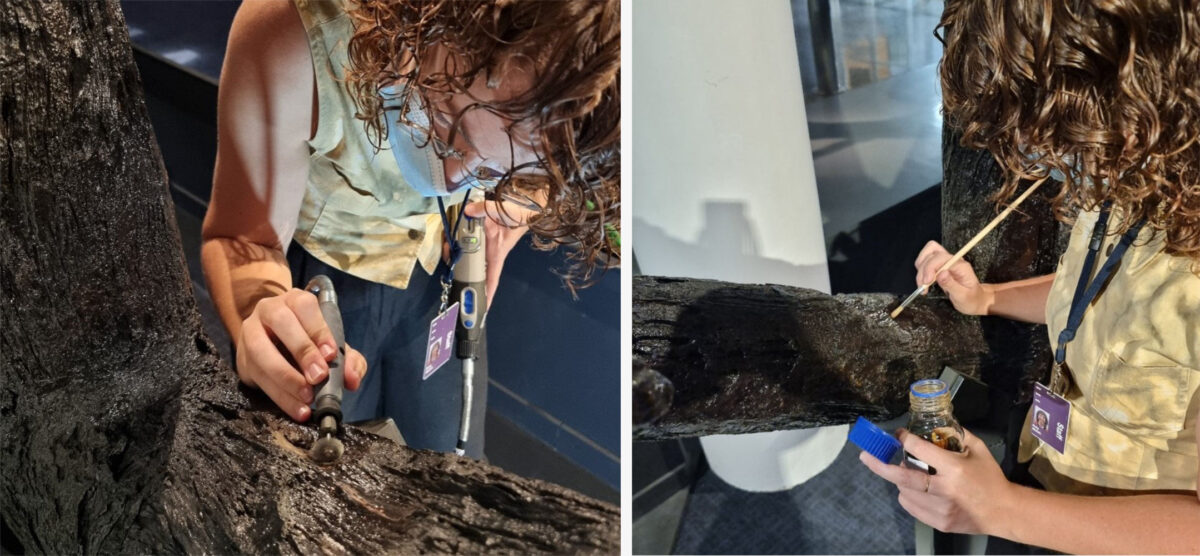
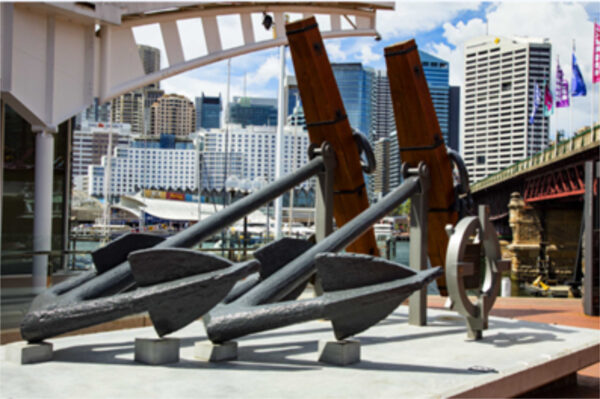
It was reported in a prior newsletter that Guykuda’s Aquarium—17 wooden sculptures of various fish species by Yolngu artist Guykuda Mununggurr — underwent anoxic treatment with the help of Alex Roach from Modified Atmospheres. Now deemed as no threat by Jeff, conservation treatment has begun. Small repairs and general cleaning of all items is required before they go on display at the end of the year. The first to undergo treatment was a white shark that required its tail to be re-attached. In correspondence with the artist, pigments used and sent by the artist were mixed with acrylic paints and used to inpaint. Using such pigments allowed the texture of the area to match the rest of the surface.
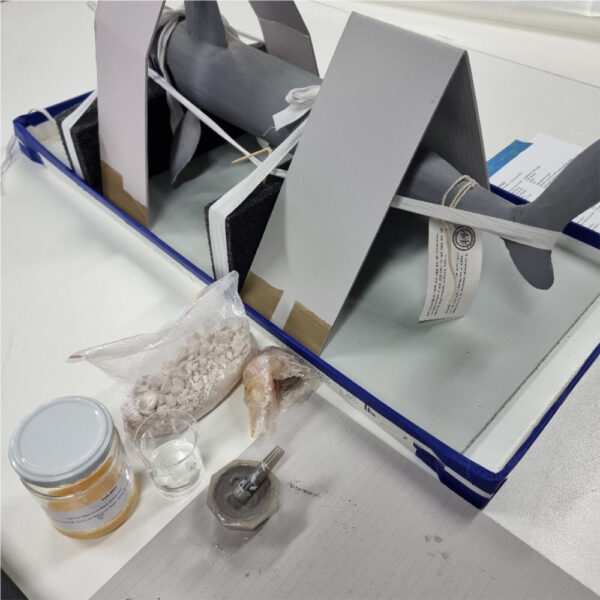
Large projects
A ‘skirt’ for Vietnamese refugee boat Tu Do was constructed from recyclable greenhouse plastic at the end of last year and in January, under the guidance of Senior Conservator Special Projects, Nick Flood, the initial rinsing of Tu Do commenced. This is the first step in the conservation process and is designed to reduce the number of soluble salts in the wooden timbers. Measurements, using a multimeter, are done daily to measure the resistance within the timbers and are mapped to determine patterns. This has also given the team time to assess the hull and determine deterioration. A large-scale ladder—of 14 steps, and 5.8m tall—was bought to access the vessel’s decking and is marginally terrifying to use due to its sheer size. With the rinsing coming to a close, the team will move on to treating mould on the interior (prepare for some spiffy pics in the next issue of us all in Tyvek suits and respirators on Tu Do’s deck), and finishing consolidation of the exterior paint, as well as some major structural repairs from Fleet.
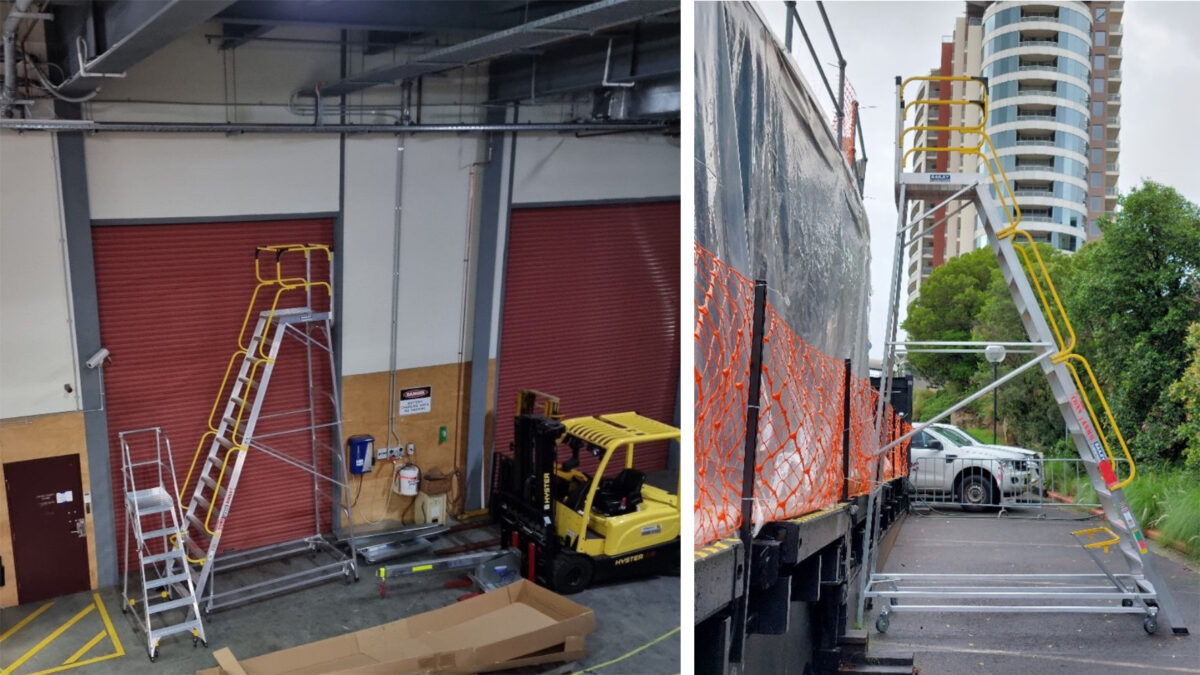
Treatment is still continuing on the HMCS Mermaid canister shots – this long-term desalination project requires collected samples to be chloride tested every six months. This gave conservators Emma Hayles and Amy Walsh the chance to learn the testing procedure.
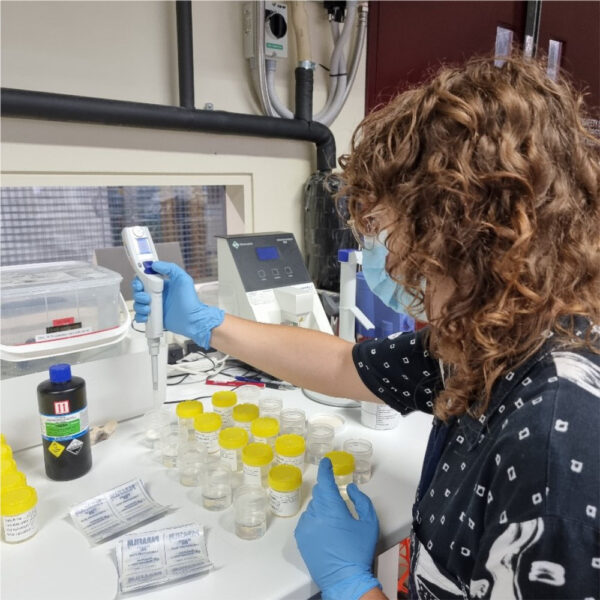
The annual engineering inspection of the Upward force on downward moving object (Wang Luyan) outdoor sculptures was overseen by Nick. The sculptures are coming to the end of their expected life and the museum, with Nick’s help, will decide their fate over the coming months.
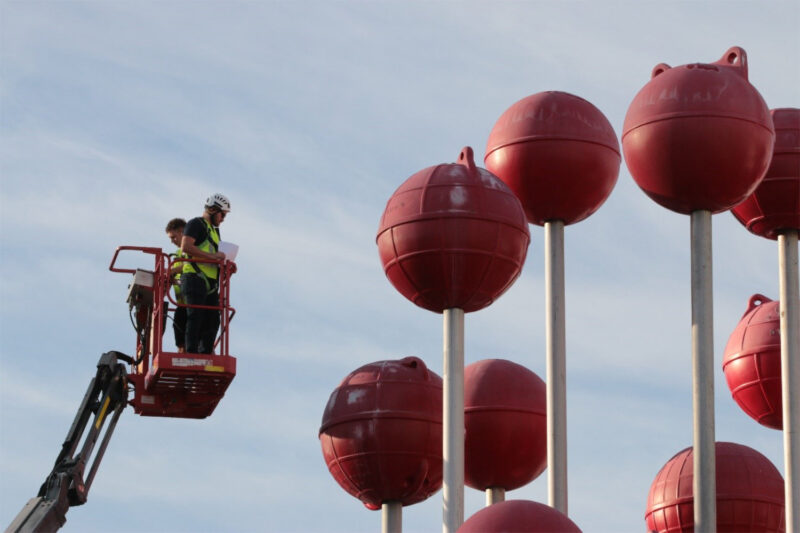
Nick also had the exciting opportunity to be involved in the announcement of the discovery of the wreck of HMB Endeavour (later renamed Lord Sandwich) earlier this year. Dressed in our best (and cleanest) lab coat, Nick watched over a table of collection objects that have associations with the Endeavour and engaged with the minister and the media.
Sustainability
The Conservation team led an initiative to collect gloves from both the Conservation and Registration teams for recycling, and managed to stuff 11.31kg of gloves into a small Terracycle box – a proud achievement.
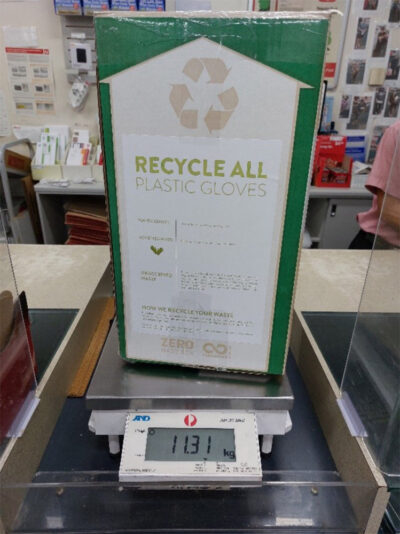
Exhibitions
It is full steam ahead with Shaped by the Sea. With the opening date set for May, Senior Conservator, Exhibitions, Alayne Avis, has been knee deep in ensuring all items are treated, supports are made and display parameters are met. The collaboration with mount-makers, designers and curators continues, especially as displaying a number of our larger items will be challenging.
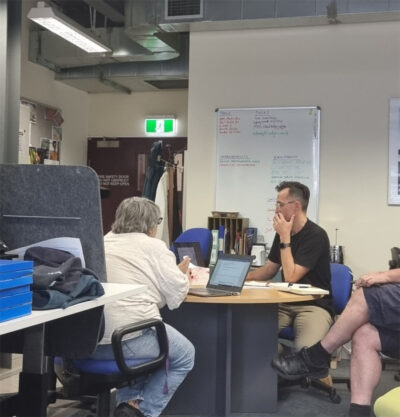
Treatment of the majority of the items for display has been completed, with stabilisation and cleaning being the main requirements.
Consolidation of paint on a yawky awk was undertaken using jun funori, pre-wetting areas with a touch of ethanol.
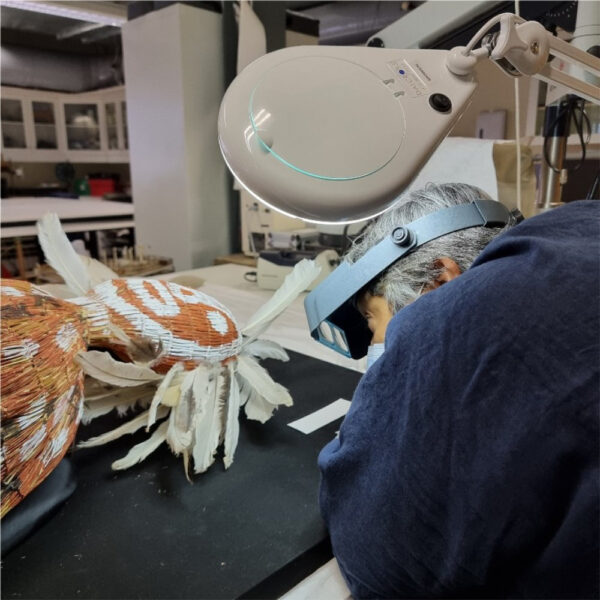
Before leaving, Amy undertook a wonderful treatment to repair delaminating mirror pieces of a sextant in preparation for display. By unscrewing the mirror, she could collect all loose pieces and slowly re-integrate using Paraloid B-72 in acetone.
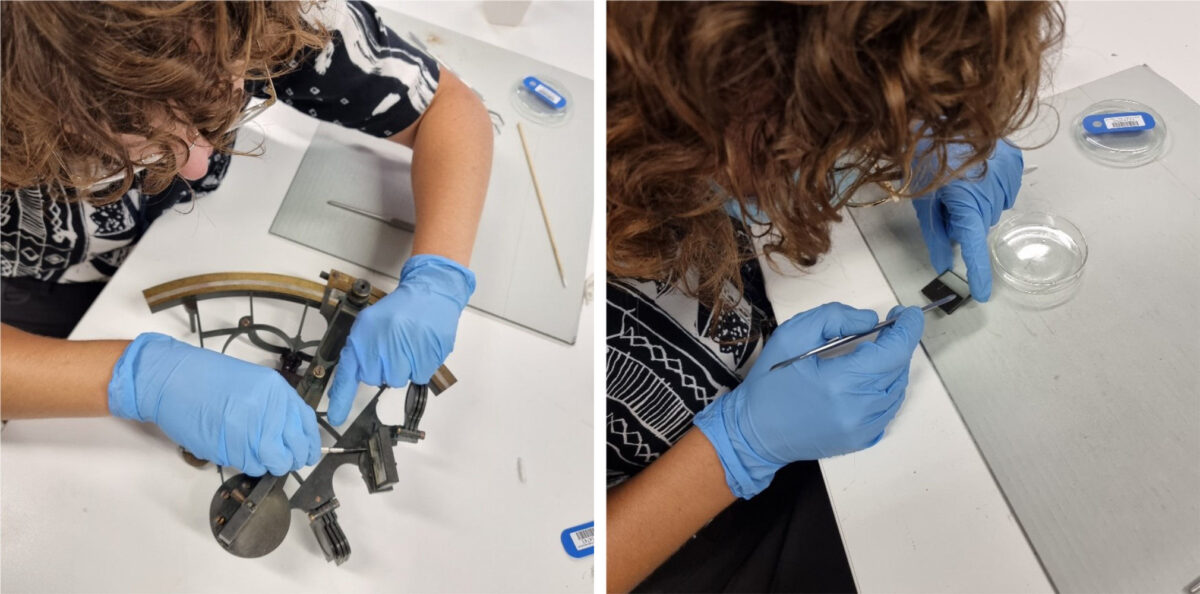
Jeff Fox was brought in to treat a number of ‘men’s business’ objects, which included brush vacuuming and assessing this dugong stand.
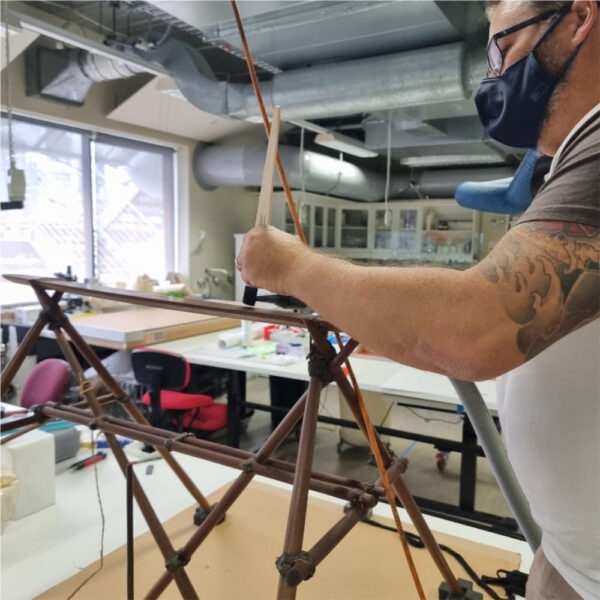
To make room for the exhibition, temporary exhibition Sanyo Maru was deinstalled and assessed as a potential travelling exhibition. As it comprises maritime archaeological objects and includes a number of organic materials, Alayne advised on what should and shouldn’t travel.
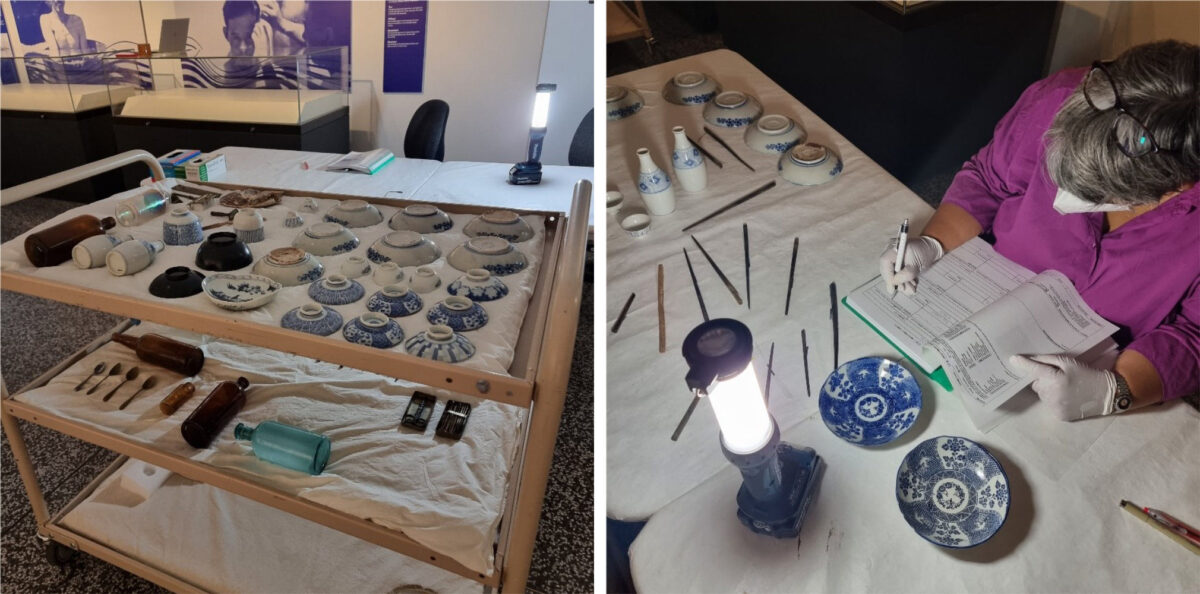
Conferences
Nick Flood attended an Inter-Society Color Council webinar, A Conversation with Nick Harkness: A Meeting of Minds – Art and Colour Science. Nick Harkness runs the Colour Made Simple online training seminar, a proud sponsor of the 2019 AICCM National Conference.
David Stein & Co
Our conservation studio is back in full swing following the lockdowns of the previous two years. The team is working on a range of exciting and challenging projects and we’re looking forward to a productive year in 2022. Following the recent heavy rain along the east coast of Australia, we have been receiving mouldy and water-damaged artworks for treatment as well as providing advice for the general public, private collections, art museums and galleries impacted by the wet and humid weather. Needless to say, we have been treating many mould-affected artworks with many more expected in the next few weeks.
Professional news
SIG conference
At the close of 2021, our conservators had the opportunity to participate in several exciting events. We had the privilege of participating in the AICCM Australian-Made 2021 Virtual Forum, the bi-annual conference for the Paintings Special Interest Group. The conference, organised by the NGV paintings conservators, was conducted entirely online. From the David Stein & Co team, Sandi Mitchell, Selina Halim, Julia Sharp, Lilian Monk, Kim Vernon and Lucy Tedder presented conference papers and posters. It was a wonderful opportunity to talk about the recent projects that we have been engaged with and to connect with our paintings conservation colleagues both in Australia and further afield. It was a great conference and a testament to the organisational talents of the NGV paintings conservators.
Virtual Mist Lining Workshop
Over 12 weeks from September to December 2021, Julia Sharp participated in an international virtual Mist Lining Workshop, conducted by SRAL in the Netherlands and funded through the Getty Conserving Canvas initiative. A total of 16 paintings conservators from around the world were selected to participate in the workshop, which was conducted by Kate Seymour and Joanna Strombeck from SRAL with invited guests from the international paintings conservation community. Weekly four-hour lectures and discussions conducted via Zoom were combined with step-by-step projects to be completed each week by the conservators in their studios, filmed and uploaded to the platform. The structure of the workshop and the information provided was so thorough that each participant was able to successfully carry out a mist lining in their studio. The program in this virtual format was a first for SRAL, who have conducted many face-to-face mist lining workshops previously. The results of the mist linings that we have conducted so far in our studio at David Stein & Co have been very promising and, where applicable, we are now able to add this technique to our conservation treatment regime.
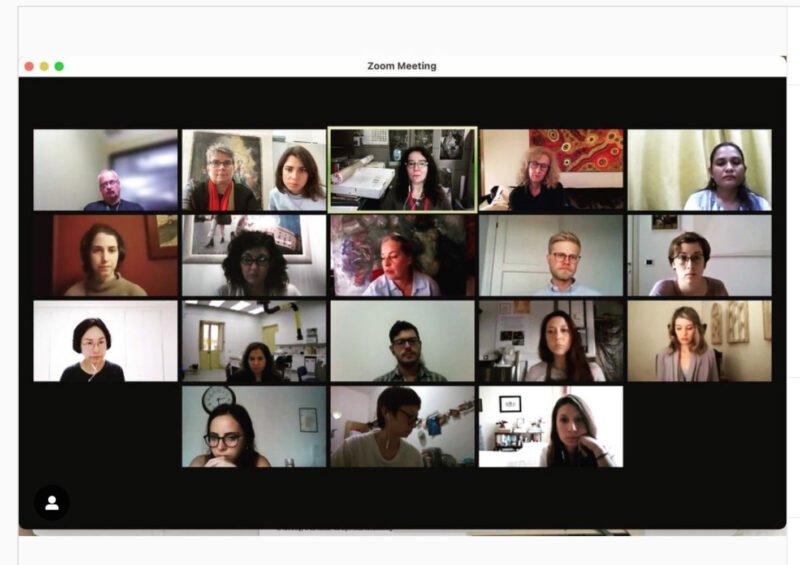
Mist Lining Workshop participants – Wednesday evening Zoom lecture.
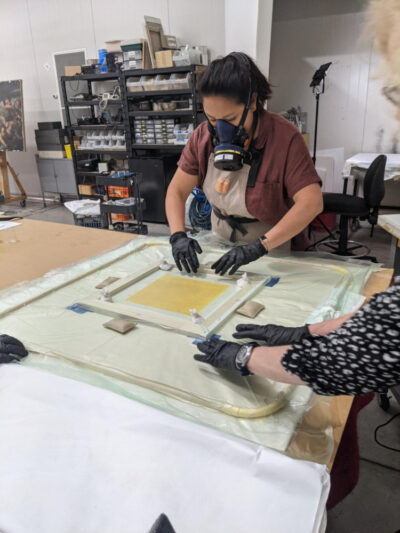
Mist lining in the studio – Julia Sharp and Selina Halim mist lining a sample painting
Onsite conservation
Late last year, we had an opportunity to revisit our Frank Stella conservation project at Grosvenor Place in the Sydney CBD. David, Katherine, Selina and Soleste Ponticello, our Registrar, spent a weekend condition checking and surface cleaning the artworks as part of their ongoing annual maintenance program.
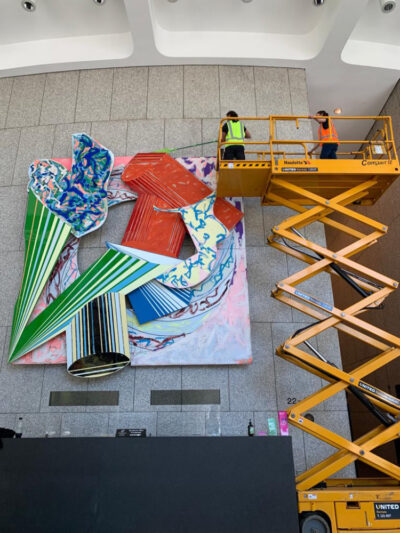
David Stein and Katherine Rosenthal condition reporting and cleaning the Frank Stella paintings at Grosvenor Place.
In the studio
Our senior paintings conservators, Sandi Mitchell and Selina Halim, have been engaged in a range of projects in the studio.
Sandi Mitchell has completed the conservation treatment to an early Ralph Balson painting from Wollongong Art Gallery, cleaning the delicate surface and removing old restorations. This painting is now on exhibition at Delmar Gallery. Following on from her paper at the Paintings SIG conference, Sandi is continuing her research into the artist Wendy Paramor and the collection at Casula Powerhouse.
Selina Halim has been working on 14 Stations of the Cross and a larger painting of Christ in Gethsemane, all from a regional NSW church. The conservation treatment to the large damaged canvas included a long complex tear repair as well as a lining with Beva film onto polyester monofilament fabric to fully stabilise the painting.
Paintings conservator Kim Vernon, assisted by other painting conservators in the studio, has recently undertaken a complex treatment to stabilise a painting by William Robinson. The painting has a history of severe and continued cleavage and flaking throughout the paint and ground layers despite several conservation treatments. The complex structural support system devised for this painting included a Beva film nap bond lining, which, in conjunction with further consolidation, has so far proved successful in stabilising the painting. This treatment highlights the evolving approach to structural treatments in the studio, focus ing on problem solving and collaboration between conservators.
Staff news
At the end of 2021, we were joined by assistant paintings conservator Monica Renn. Monica gained her master’s degree in conservation of paintings from the University of Northumbria, UK, and was previously employed at Fine Art Restoration Company in Carlisle, UK. She is a wonderful addition to our team.
In January, we happily welcomed back paintings conservator Ellie Gifford from maternity leave. Ellie’s son Leo was born early in 2021.
In February this year, we were joined for three weeks by paintings conservation student intern Jordan Aarsen as part of his studies at Melbourne University. During his internship, he carried out a challenging treatment to a large painting, a hard-edge abstraction by Gunter Christmann. The treatment included removal of embedded stains in the very matte porous surface. He will be joining our team as a conservation assistant and will also be a wonderful addition.
David Stein and Co, with the combined creative genius of David and Soleste, was the very well deserving winner of the Woollahra Christmas Window Display Competition for the ‘Christo’- themed decoration in the front window of our Woollahra studio. David Stein and Co’s ‘Christo-mas’ was a standout winner from a very competitive field.
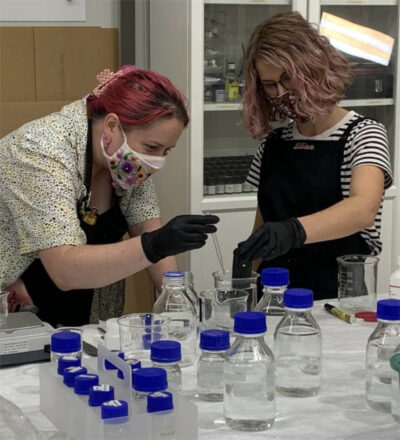
Conservators Monica Renn and Lilian Monk preparing aqueous cleaning solutions in the studio.
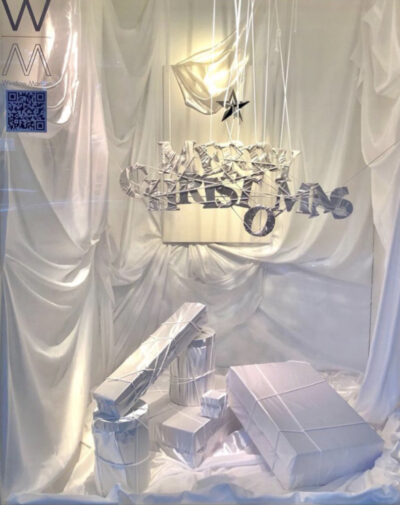
Christo-mas’ window display at our studio in Woollahra.
International Conservation Services (ICS) – Sydney
Paintings
The Paintings Team has a big variety of projects in progress. Work continues on a Dutch still life painting in collaboration with the National Trust, Matteo Volonté has been repairing a Sidney Nolan painting that was damaged when it fell off a wall, and Claire Heasman has been repairing a tear for the Mosman gallery. Claire is also working with Eden Christian on a paint analysis project at the heritage-listed Lands building in the Sydney CBD.
Matteo, Claire, Eden, Suati Rojas, Lucy Tedder and Alis Jitarescu have spent many months at the Bondi Pavilion, which is undergoing major renovations. Three murals were discovered in the theatre (the old ballroom), each depicting a different style of dance. The murals were painted in the 1930s, painted over at some point in their history, and then rediscovered in the 1970s. After removing layers of overpaint, the team uncovered, restored and conserved these historic murals, returning them to their original splendour where they can now be seen and enjoyed by all. In the process, several additional murals valuable to Bondi’s heritage were also discovered, including an outside courtyard mural that was part of a larger community art project ‘Bondi the Beautiful’, and we are now working to conserve these as well.
Most recently, we have been busy with an influx of mould triages on paintings affected by the recent heavy rains and flooding.
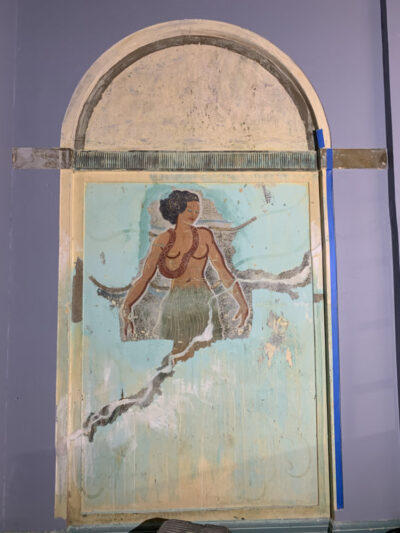
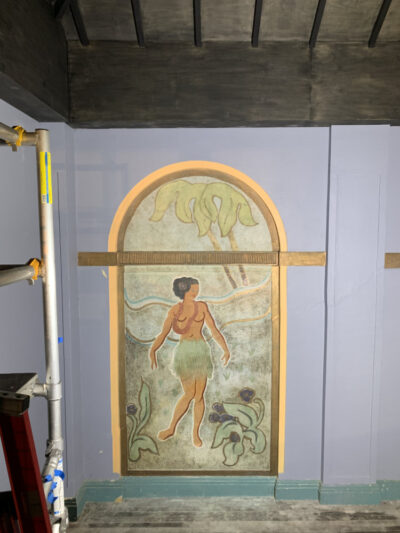
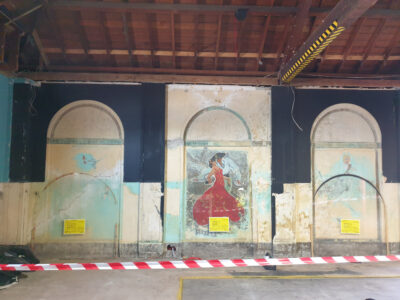
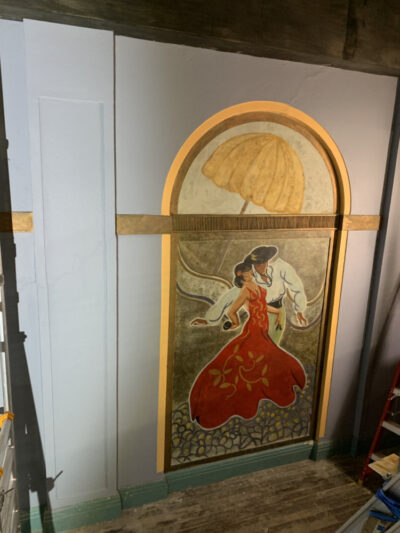
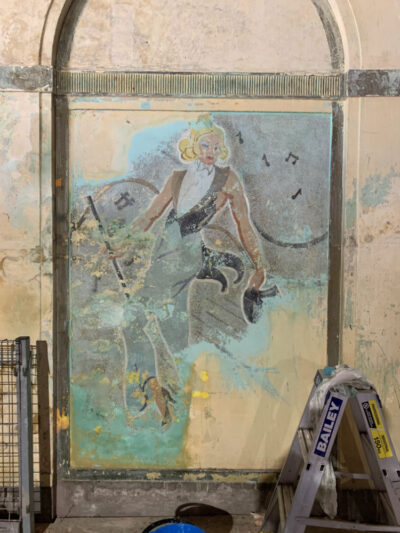
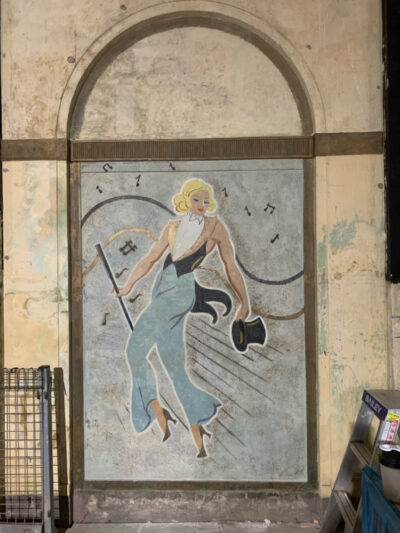
Before and after overpaint removal, uncovering the historic murals at Bondi.
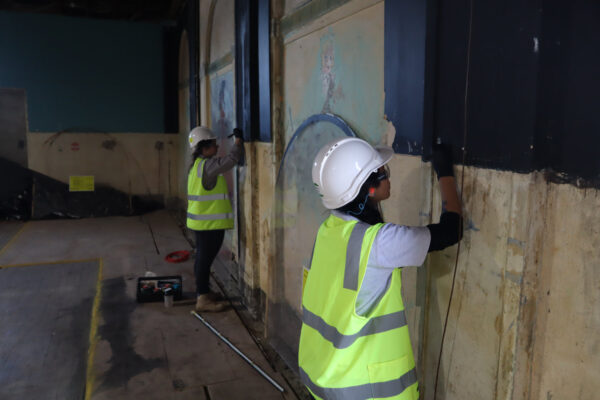
Eden (L) and Suaty (R).
Textiles
It has been a busy few months for the Textile Team. Bella Taylor has worked tirelessly on the preparation and mounting of 12 Sydney Living Museum costumes to facilitate their digitisation, and Fiona Tennant is currently overseeing the final digitisation process. Two Coburn tapestries and three large carpets from a private collection were deinstalled, cleaned and reinstalled with the help of Fiona, Bella, Alis, Kristina Taylor and Elric Ringstaad from the OOH and Framing teams respectively. In Canberra, Christina Ritschel has completed the stabilisation of a National Trust white cotton lace dress and a delicate 1920s shawl from a private collection. Christina, Natalie Fairhurst and Doug Rogan, also deinstalled three large Matégot tapestries from the National Library, put them through a freezing treatment for pest management, and will soon move onto the treatment stage. In the meantime, Natalie and Christina are working on the stabilisation of a fragile tapestry from a private collection in Brisbane.
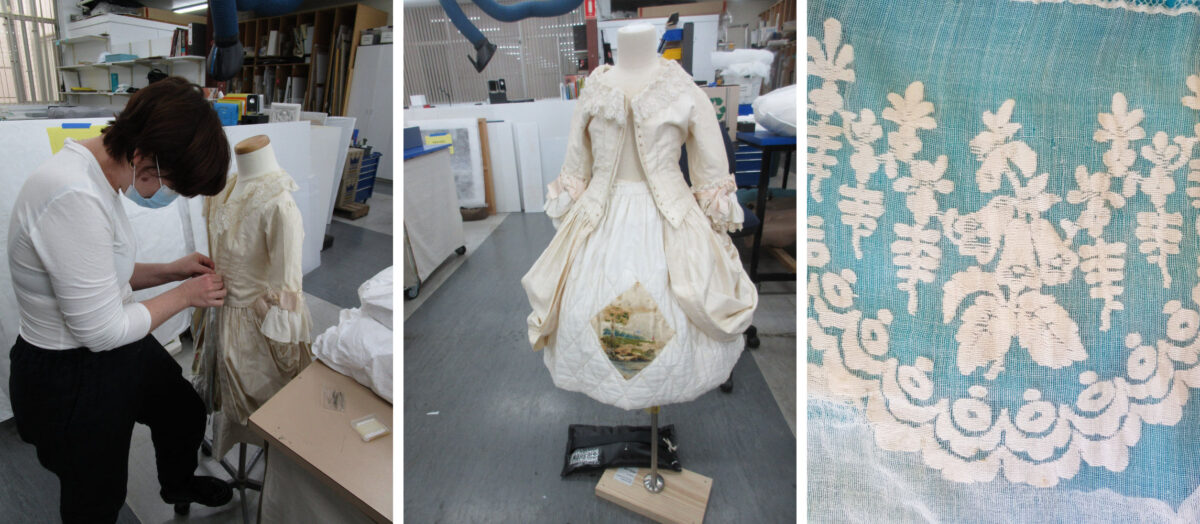
Bella working on the ‘Little Bo Peep’ dress.
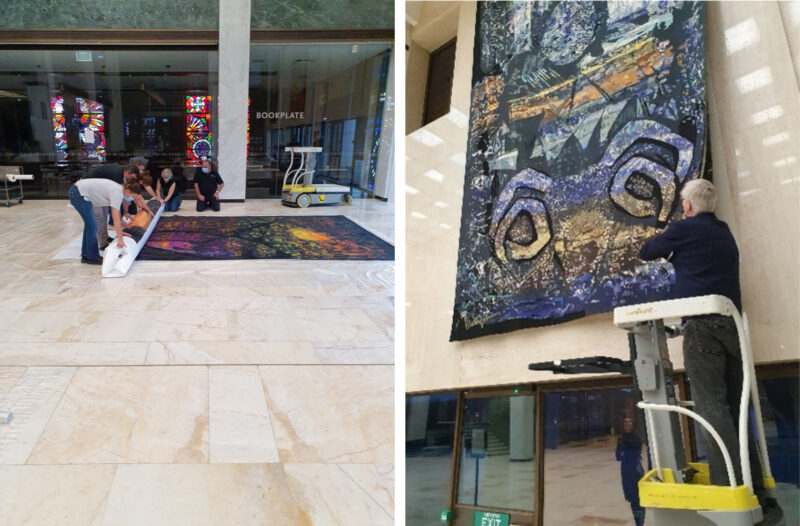
Assessment and removal for conservation of the National Library’s Matégot tapestries
Objects & Outdoor Heritage
In December, the OOH Team farewelled Head of Conservation, Nicola Ashurst, who has returned to her consulting practice whilst continuing to work with ICS on a range of projects. We also farewelled Conservation Project Coordinator Grace Bushrod, who is taking on an exciting role at MAAS. Nicola led the OOH Team admirably through uncertain pandemic times, sharing her wealth of knowledge along the way, and Grace provided amazing support and project management skills. Thankfully these are not sad goodbyes – we are looking forward to working with Nicola as a consultant into the future and we know Grace is not far away from us in Sydney!
In other people news, the OOH Team has welcomed Richard Isaacs into the role of Conservation Project Coordinator and Amy Walsh has returned to her role as Objects Conservator. In Nicola’s absence, Claire Rowson has stepped into the Head of Conservation role in an acting capacity and has been doing a fantastic job keeping the team on track.
OOH also wished Wendy Reade a temporary bon voyage as she jetted off to Jordan to undertake archaeological conservation work for six weeks. We look forward to hearing about her adventures when she returns!
In late December, Claire, Keir Bayley and Alis Jitarescu spent time in Canberra undertaking conservation works on two large outdoor sculptures, Ethos by Tom Bass and Fractal Weave by David Jensz. In addition to comprehensive cleaning, corrosion treatment and waxing for both sculptures, Keir completed some beautiful hot repair work to Ethos’ injured toe.
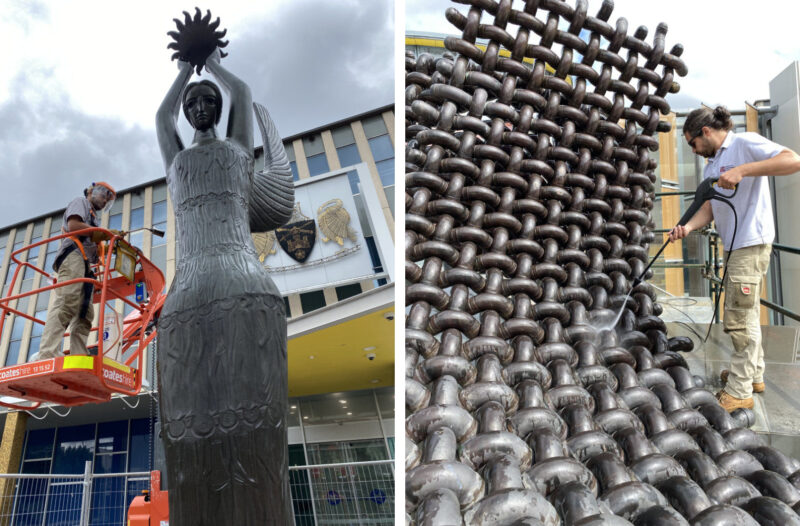
Keir at work on Ethos and Fractal Weave. Images by Claire Rowson.
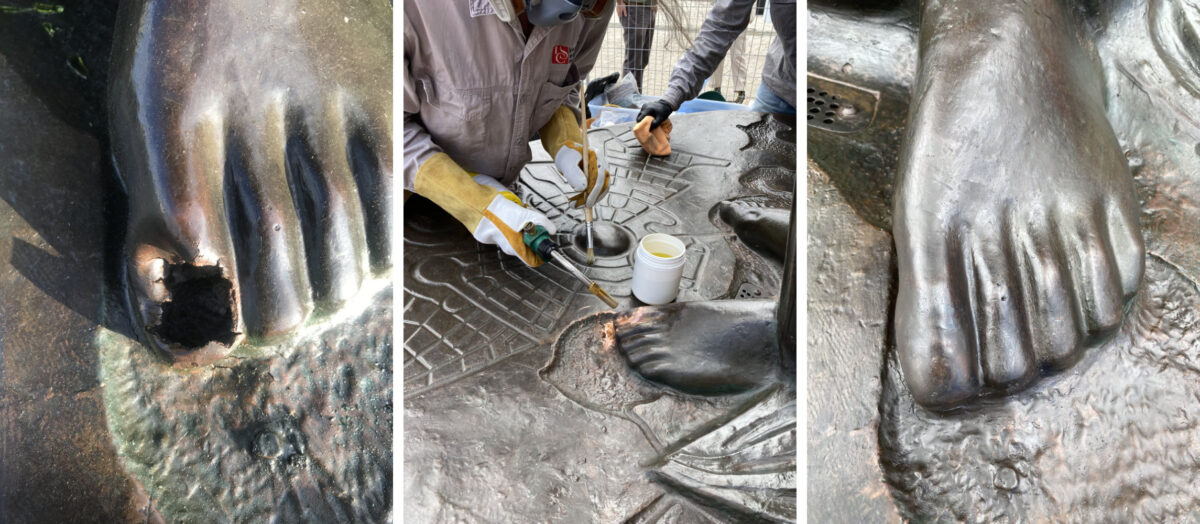
Toe surgery, before, during and after repair works on Ethos. Images by Claire Rowson.
Keir and Alis have since returned to Canberra to assist with damage remediation works at Old Parliament House, in the wake of a fire lit during protests in late December. Keir has assisted with repatination of the copper alloy window frames and Alis is working on a treatment methodology to conserve the unique flooring.
Back at the lab, Alis has been carefully removing beige overpaint from one of the Stations of the Cross from Goulburn Cathedral. Following thorough testing, she has been able to reveal the beautiful original decorative polychrome scheme!
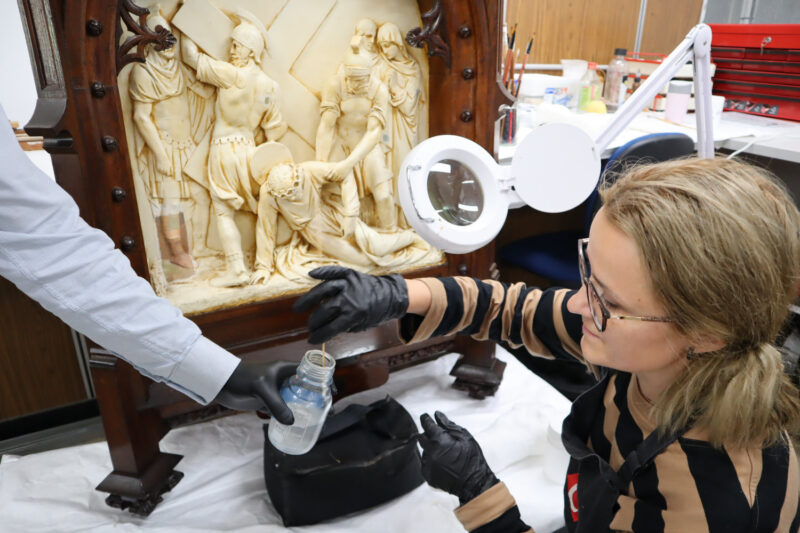
Alis at work, revealing the magical original polychrome surface. Image by ICS.
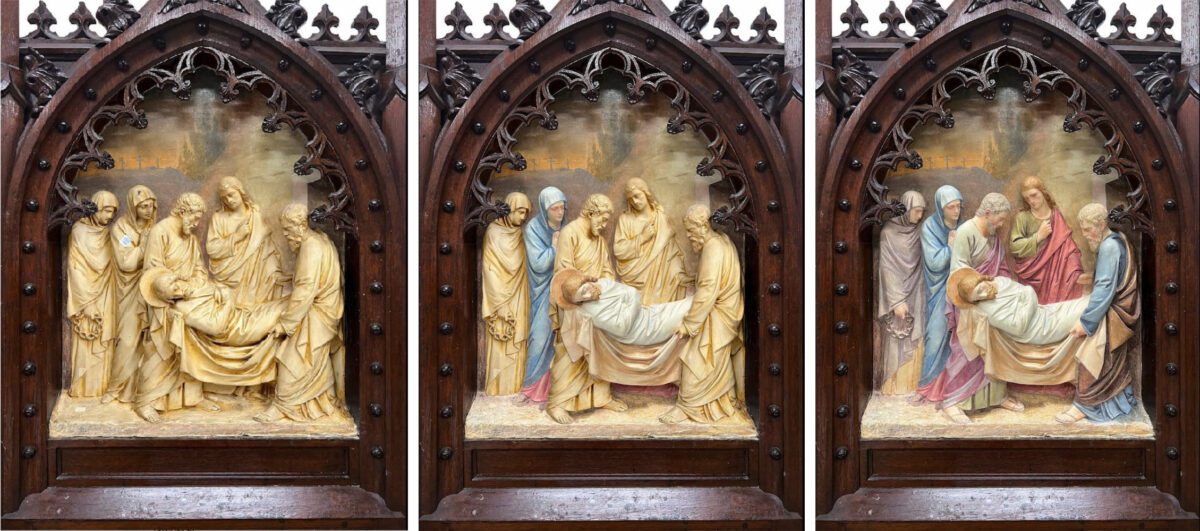
The Station of the Cross, before, during and after overpaint removal. Images by Alis Jitarescu.
Claire has recently overseen installation of complex scaffolding within the Grand Staircase at Sydney Town Hall in preparation for extensive works to stabilise and reinstate the decorative finishes on the ceiling.
Amy, Richard and Kristina Taylor recently safely packed up a private collection of ceramics and glass at a beautiful location in Mosman. Richard produced a detailed photographic catalogue of the collection and Amy and Kristina worked to devise bespoke packing solutions for each delicate piece.
With many jobs planned for Sydney and interstate, the ICS OOH Team is excited for the busy year ahead.
Paper
We have been inundated with requests for estimates and with water damaged works as a result of the recent downpours in NSW. These include lots of deframing in our spray booth to dry out artworks.
Caroline Whitley and Katie Wood spent three days working on a Chinese ancestral painting at White Rabbit Gallery. The large work—painted on fine tissue, which was adhered to a linen backing—is thought to be from the Ming dynasty. The work had sustained many losses, staining and overall bad handling/storage damage over the centuries. The adhesive had failed in many places and the paper fibres had weakened and were lifting away from the linen support. Areas with green pigment were especially fragile and crumbling, probably due to a copper component. They spent the three days carefully pasting down and consolidating the lifting paper.
Caroline visited the Murdoch’s for an annual clean of their rare book collection.
Caroline has also been doing cleaning and stain removal treatment of a 17th century Mercator map of the East Indies.
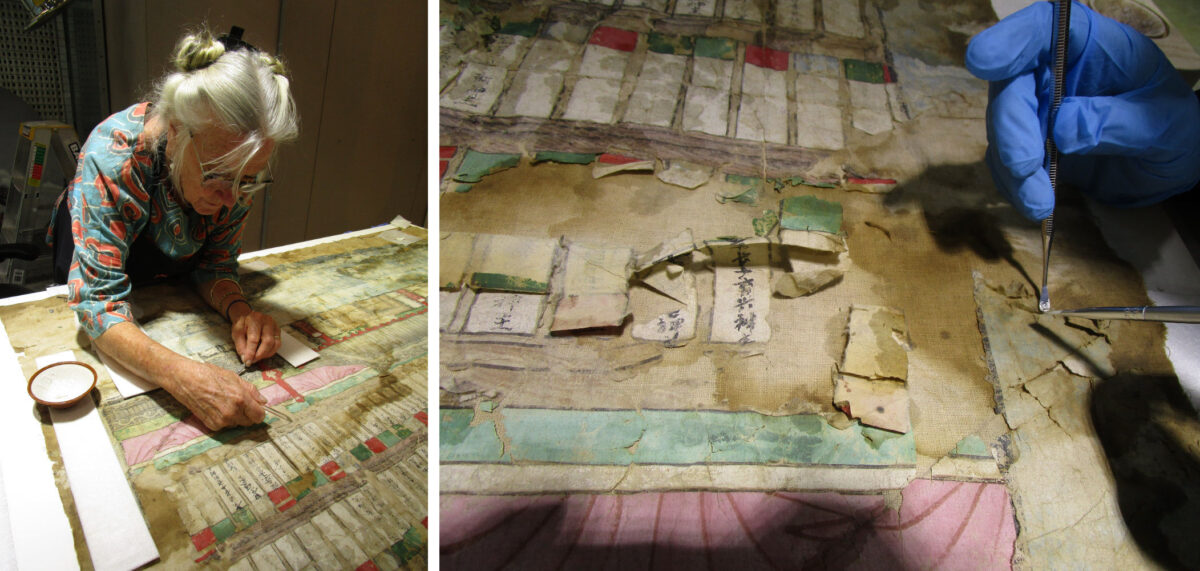
Caroline (L) and Katie working on the painting.
Furniture and Wooden Objects
The most significant project the Furniture and Wooden Objects Team has been working on this year has been restoration of the Old Parliament House fire-damaged doors. Since 1927, these solid jarrah doors have been an integral part of both the building itself and Australian national heritage. During protest activity on 30 December 2021, the doors were extensively damaged by arson and, due to their heritage value, ICS was enlisted to conserve them. Conservators Oliver Hull and Doug Rogan, as well as Julian Bickersteth, assessed the doors on site, later removing them for transport to Sydney. Their assessments revealed that restoration was possible, despite serious damage to the top two layers of timber. Much of the wood and fittings were salvageable—great news as it was initially feared they has been burnt beyond repair—with brass doorknobs and push panels excavated from the ashes. Despite needing new glass, decorative finishings and a new top layer of wood, the original jarrah core will be retained.
The doors are now being carefully worked on almost daily by Oliver, as well as conservation technician Justin McDonnell, another great new addition to the ICS team, with assistance from Keir Bayley. To prepare the doors for conservation work, the first step was to safely remove loose glass and then the metal fixtures within the door. Taking into account heritage considerations due to their age, solvents were injected into the doors to break the glue bond, softening them to allow pieces to be mechanically removed. This gave access to the stable jarrah core beneath, which was then cleaned by removal of old adhesive. The next stage involves stabilising the doors to ensure they retain their shape and form, and then stabilising between split layers and re-adhering these together.
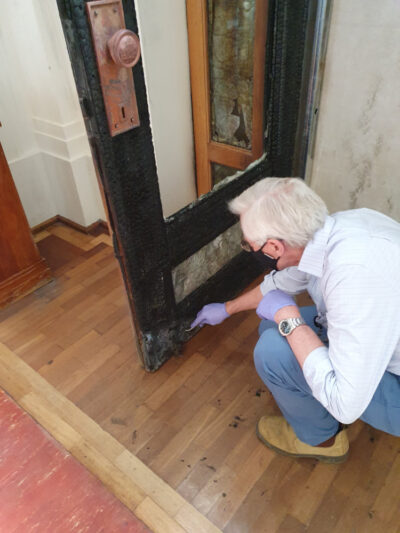
Julian Bickersteth assessing the doors.
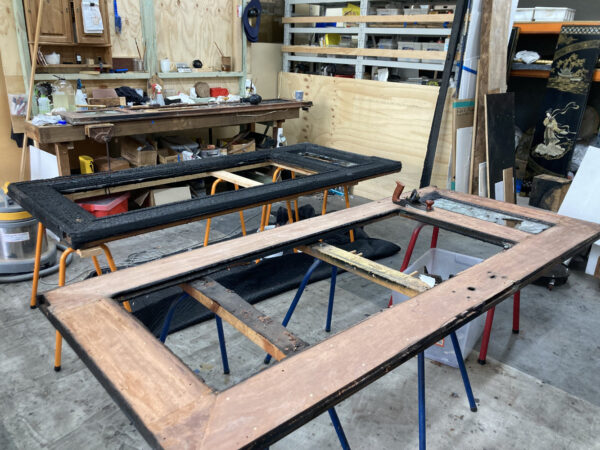
Pre and post removal of the charred exterior layer.
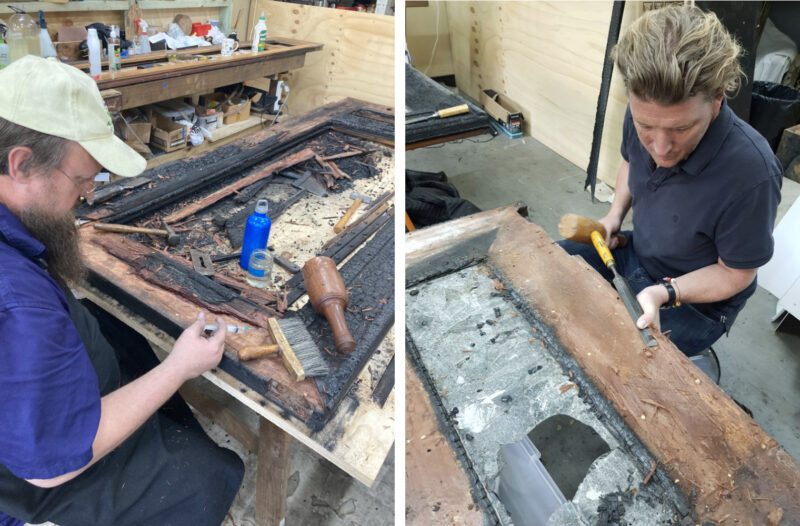
Justin (L) and Oliver (R) injecting solvents to remove the top layer of charred wood.
Museum & Gallery Services
In the days after the first Lismore flood in March 2022, Julian Bickersteth, Fiona Tennant, and Adam Godijn worked solidly with Lismore Regional Art Gallery and the Lismore Museum (Richmond Historical Society) and Create NSW to strategise on emergency salvage procedures to save as many artworks and objects as possible from the total inundation of both buildings. Within three days of the disaster, we were able organise a conga line of IAS trucks heading north, stopping off at various Bunnings outlets on the way to pick up materials that were in short supply or not available in the flood- affected areas. Kay Soderlund and Julie McCarthy travelled separately and were accommodated by a Lismore Gallery staff member. They worked tirelessly with IAS staff in difficult conditions (no electricity, running water, amenities) to transfer the entire contents of the Gallery and some from the Museum into trucks heading for cold storage in Brisbane. Some items, such as the Hannah Cabinet, are now with Greg Peters in Canberra for the long restoration process, and Kim Morris in Canberra has received 40 Afghan rugs (that were on loan from the ANU) for remediation.
We are now moving to the next stage of assessment for salvageability followed by the long journey of remediation and, finally, return to Lismore.
The Lismore floods have demonstrated the power of community goodwill in so many ways during this humanitarian disaster. In turn, the conservation community rose swiftly and collaboratively to meet the challenge of saving our cultural heritage during this unprecedented weather event.
Museum of Applied Arts and Sciences (MAAS)
MAAS is working with other Sydney-based cultural institutions and Create NSW to provide coordinated assistance to the Northern Rivers Regional Museums and Galleries in response to the recent flood disaster.
MAAS was able to provide climate-controlled storage at the Museums Discovery Centre for three cabinets made by Mr Geoff Hannah, who also made the Hannah Cabinet that was on display in the Lismore Regional Gallery. The Jubilee, Chinoiserie and Wenge cabinets had been totally submerged during the flood. They arrived in Sydney in multiple parts and had a fine layer of mud and silt. The varnish exhibited bloom in some areas, metal components such as locks and keys showed corrosion, and mould was developing. Our Conservation team documented the cabinets and removed as many drawers as possible to facilitate air circulation and promote drying. The cabinets are being checked daily for mould and to monitor their condition.
Staff changes
Paper Conservator Karina Lavings has been appointed as Conservator at the State Archives and Records Authority of NSW. Karina started at MAAS as Deputy Conservator Team Leader of the CRD Assessment Team and has contributed significantly to the success of both the assessment and conservation treatment phases.
The CRD Special Collections team bade farewell to Monica Connors, who has been appointed as Conservator by the National Film and Sound Archive in Canberra, and Bindiya Kumar who has been appointed as Assistant Conservator at the State Archives and Records Authority of NSW. We welcomed Assistant Conservators Cancy Chu, Patrice Holstock, Eliza O’Donnell, Julia McKenzie and Daniel Bornstein to the team.
Events
In February, as part of the Powerhouse Museum’s 2022 Regional Public Program, Suzanne Chee presented a webinar on Making Invisible Mannequins. The webinar was well received by 102 attendees from 62 regional collection organisations who tuned in for the online presentation.
CRD Project and treatment update
Karin Lavings and Beate Yule have completed treatment of 1900 paper items from the Museum’s general collection. Beate is now focusing on MAAS’s extensive archives, identifying priority items in collaboration with archivist Paul Wilson. These items will be prepared for digitisation until the end of the paper conservation phase on 30 June.
In 2021, MAAS commissioned the Ordre Group to produce 360° interactive object photography as a planned phase of the CRD Project. Three hundred significant objects were digitised as part of this project (including 100 fashion outfits, 100 accessories and 100 objects), in a manner that provides 360° interactive and multi-angle views, and captures intricate details, embellishments, markings and silhouettes, resulting in new levels of access to the Museum’s extraordinary collections.
The Special Collections phase of the CRD Project will finish at MAAS on 31 March 2022. The Special Collections Team has assessed 211 collected archives as well as finalising assessment of the general collection.
Conservation research
Brooke Randall and Kerry Etherington from the Grimwade Centre for Cultural Materials Conservation have analysed a further 120 items from the Museum’s Penfolds Plastic collection as part of the ARC- funded PolyMuse Project.
Brooke Randall is working with Sydney Analytical to analyse the Museum’s collection of Chinese toggles using near-infrared and Raman spectroscopy. The results of this research will be featured in an upcoming exhibition at the Chau Chak Wing Museum and the accompanying publication.
MAAS has embarked upon a collaborative research project with Western Sydney University, Swinburne University of Technology and Utrecht University Netherlands to investigate how museum collections, many of which have histories entangled in Australia’s high emission sectors that supported the nation’s economic growth, can be curated to support climate change mitigation. Drawing together the disciplines of biogeochemistry, museology, environmental humanities, Indigenous knowledge and education, the project anticipates enhancing MAAS’s capacity for climate action through innovative programs. Its benefits include developing new collections-based climate research that incorporates the perspectives of multi-stakeholders, including Indigenous Australians. Bronwyn Dunn will be assisting this research at the Museum Discovery Centre, with support from Brooke Randall.
Exhibitions
The Exhibitions conservators have dismantled Fantastical Worlds, which will travel to the David Roche Foundation in Adelaide, opening mid-August. In February, this year’s Shape exhibition was installed. It showcases major works by HSC design and tech students.
Future Fashions also opened in February as well as the Powerhouse Architectural Commission – Cadeau located next to the Museum on the Ultimo Goods Line.
Another interesting exhibition is 100 Climate Conversations, which showcases 100 visionary Australians taking effective action on climate change. The conversations are filmed in front of a live audience at a bespoke auditorium built within the Boiler Hall at Powerhouse Ultimo.
Preparation work is underway for Unpopular, a major exhibition celebrating the music and culture of rock and indie bands touring Australia in the late 1980s to the 1990s and the history of Modular Records, an Australian record company.
The Powerhouse Museum is currently developing a major exhibition to celebrate the life and achievements of Carla Zampatti. The Museum recently made an appeal to the public—‘The search for missing Carla Zampatti treasures’— in a quest to increase the number of garments and accessories to be included in the exhibition.
Bronwyn Dunn and Suzanne Chee have embarked upon a reorganisation of the entire mannequin collection at the Powerhouse Museum. Up till now, mannequins were stored in various locations around the Museum as well as at the Museum Discovery Centre, making it very difficult to count and locate them. Approximately 300 mannequins have been moved to a designated storage area at the Museum Discovery Centre, Castle Hill, organised by style, and labelled, forming a mannequin ‘library’. Each will have a registration number that will allow tracking, management, and auditing of the mannequins in the KEmu data management system, making locating mannequins easier for upcoming exhibitions and loans.
O’Sullivan Conservation
Staff news
Nicole Reynell has been welcomed to the team as Conservation Technician. Nicole comes to O’Sullivan Conservation with a background in metals patination and maintenance, and client management. She has been an invaluable asset to our recent conservation work, and we look forward to her future with the company.
As you may have seen, O’Sullivan Conservation is currently recruiting for two vacant positions, Assistant Objects Conservator and Objects Conservator, offering the opportunity to work with a diverse range of objects and artefacts on both private and corporate projects. Feel free to get in touch with Hannah Newman if you would like further information or to apply.
Professional news
Our Director, Eoin, is back from the Mawson’s Huts Foundation expedition to Cape Denison, Antarctica. The experience provided unique challenges to standard treatment practices, given the harsh environment and the lack of access to suppliers. There was also an unexpected benefit – Eoin successfully avoided the peak of Australia’s most recent COVID-19 wave, Omicron. The expedition was a singular opportunity and an extraordinary experience and, as a result, Eoin has vastly increased his knowledge of both conservation in challenging environments and penguins!
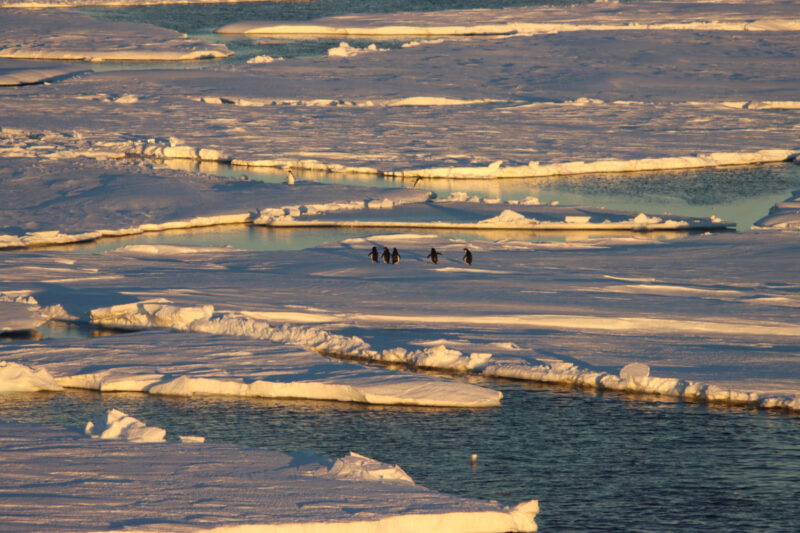
Adelie penguins crossing the sea ice at sunset.
Expedition photographs and first-hand accounts are available on the Mawson’s Huts Foundation Facebook page. Photographs can also be viewed on their Instagram page.
Eoin and Hannah will be virtually attending the AIC’s 50th Annual Meeting and Conference in May. Hannah is particularly looking forward to the Collection Care Network sessions and Eoin to the Objects and Wooden Artifacts seminars. They are currently waiting on the final schedule.
Treatment projects
It has been business as usual at O’Sullivan Conservation, with a variety of projects both undertaken and in the works. The rain did not put a damper on our activities – though we did get quite wet at times! We feel for all those individuals and organisations affected by the recent flooding and are well-versed in mould remediation, conservation of water-damaged objects and furniture, and other relevant treatments, should there be a need.
During December and January, the team undertook several projects, including the condition assessment and conservation cleaning of a set of sandstone memorial gates and the conservation treatment of a Bills’ horse trough, both in Kearsley, and the conservation treatment of an early Australian cedar chiffonier, circa 1850.
It is a testament to the team’s skills that business can continue relatively normally with Eoin working remotely for such a long period, and we want to thank them for their hard work.
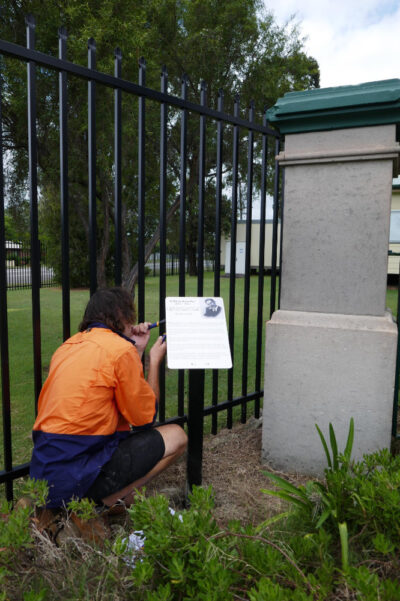
Staff installing the interpretive plaque at the Kearsley Gates.
In February and March, O’Sullivan Conservation completed the conservation of the Victor Chang Memorial and the Gosford Rotary War Memorial Fountain, among other projects.
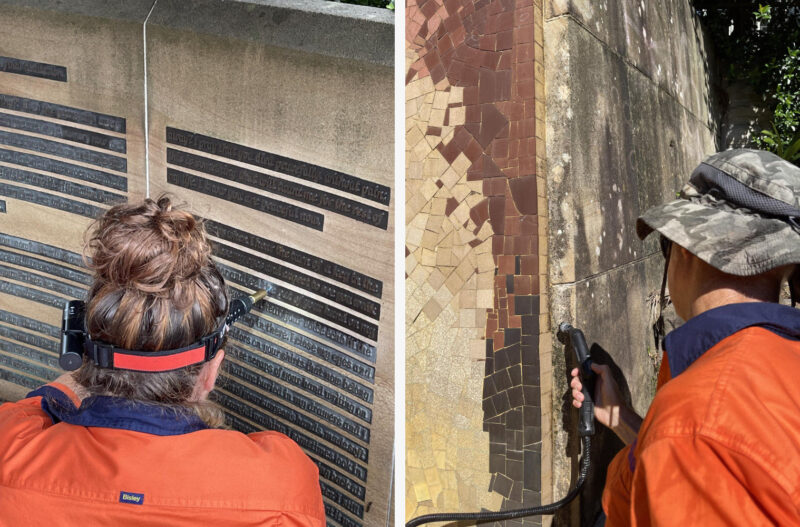
(L) Nicole waxing the Victor Chang Memorial.
(R) Staff steam cleaning the tiles of the mosaic wall at the Gosford Rotary War Memorial Fountain.
We also undertook the regular maintenance of Tracy Emin’s installation The Distance of Your Heart. O’Sullivan Conservation also returned to the Royal Sydney Golf Club to conserve its Robertson Collection, and Eoin thoroughly enjoyed working with wooden objects once again.
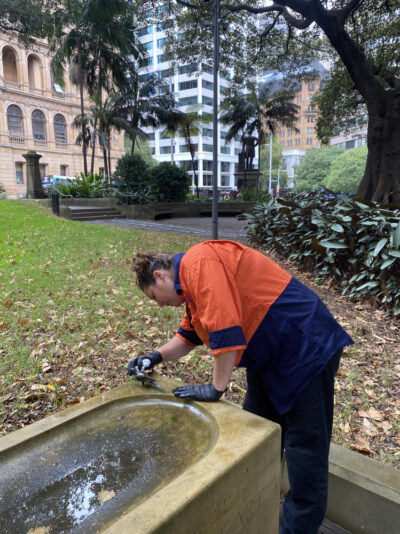
Nicole cleaning one of the birds from The Distance of Your Heart, enjoying the weather before the heavy rain.
To our delight, the company was engaged to undertake another project for Dubbo Regional Council, completing treatment on the Australian Hero wagon located at the Western Plains Cultural Centre (WPCC) following damage from a collapsed ceiling during a storm event. It has been a particularly exceptional quarter for wooden objects!
Eoin can be seen working on the wagon on the WPCC Instagram page, and WPCC can be seen protecting it following the storm event here.
The team has recently commenced work on a mould remediation project for a furniture and objects collection, with Hannah taking the lead as she focuses her conservation skillset on collection and environmental management.
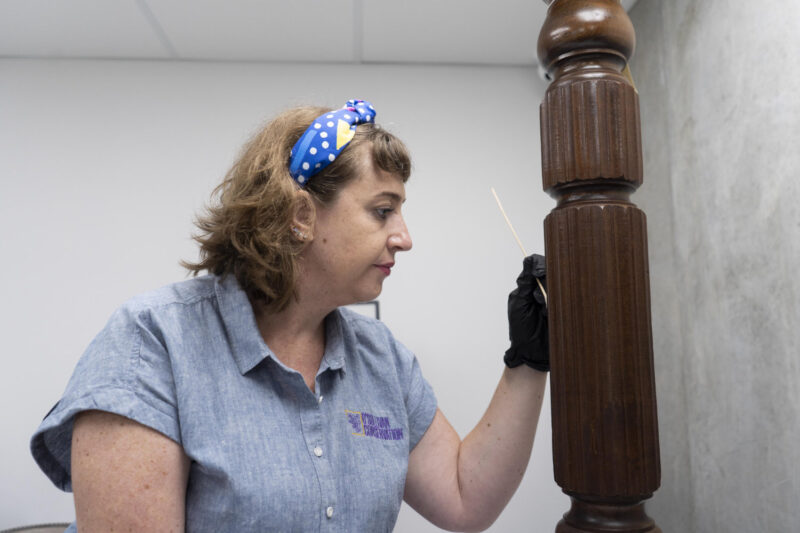
Hannah undertaking mould remediation works on a turned reeded cedar pedestal.
State Library of New South Wales
Staff changes
Senior Conservator Catherine Thomson has accepted a two-year secondment as Head, Collections Care, at State Archives / Sydney Living Museums. This is an exciting opportunity for a highly valued colleague. We congratulate Catherine on this well-deserved appointment and will miss her very much!
Professional news
Books, Objects and Paintings
At the end of 2021, Felicity Corkill, Catherine Thomson, Caroline Lorentz and Lauren Dalla deinstalled about 3000 objects from the Collectors’ Gallery display prior to major building works, and returned them to storage. This year, the team is recommencing a long-term project to rehouse the realia collection and plan for its new storage, which will be constructed following the building renovations. The reinstallation of a large quantity of items to the Collectors’ Gallery is expected to commence in February 2023.
Digitisation
The Library’s digitisation program wraps up at the end of this financial year, so the team is busy working across the tail end of multiple projects. Keyeele (Kiki) Lawler-Dormer and Hoa Huynh continue their complex treatment of thin iron-gall letterpress correspondence in the George King papers. The duo has successfully released the leaves from adhered stacks in bound volumes. They are currently experimenting with methods of lining leaves suffering from extreme lacing, loss and creases. In the image below, Kiki is gently pressing papers undergoing ultrasonic humidification inside a domed suction table. Once humidified, the papers will be lined with remoistenable 3% gelatin 5gsm Japanese tengucho tissue paper, which will be remoistened with 1.5% gelatin prior to adhesion to the leaves.
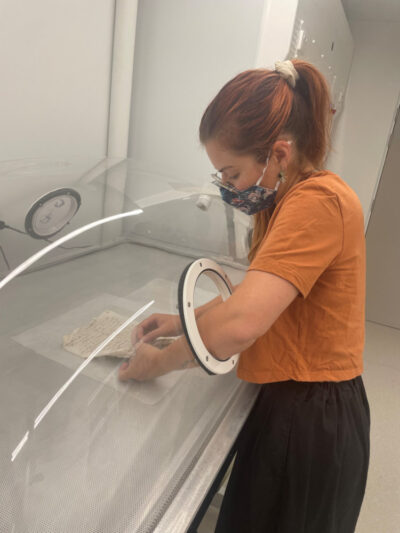
Keyeele Lawler-Dormer humidifying George King letterpress papers under domed suction table. Image credit Hoa Huynh.
Paper and Photographs
Conservators Cathryn Bartley, Cecilia Harvey, Kate Hughes, Dana Kahabka, Trish Leen, Nichola Parshall and Wendy Richards have been treating a selection of 19th century panoramas for the opening of the Library’s new Works on Paper Gallery. The panoramas are watercolours, drawings and printed views of Sydney, greater New South Wales, Australia, Baltimore, Kolkata (identified as Calcutta on the item), Constantinople and Singapore. The panoramas are up to 5.8m in length, in continuous and segmented formats, and have ranged widely in condition with lots of historical intervention. Treatments have included backing removals, adhesive and stain reduction, loss compensation, repair and sympathetic retouching. The backing removals led to the discovery of preliminary sketches and even a missing piece on the reverse. Several unique watermarks have been documented, all of which will feature in the accompanying gallery guide.
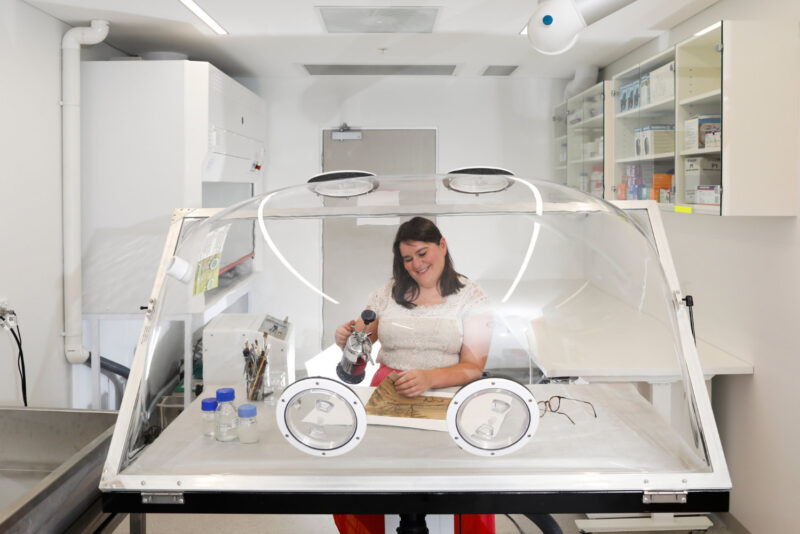
Kate Hughes treating watercolours for panaromas exhibition on a suction table. © State Library of NSW. Image credit Joy Lai.
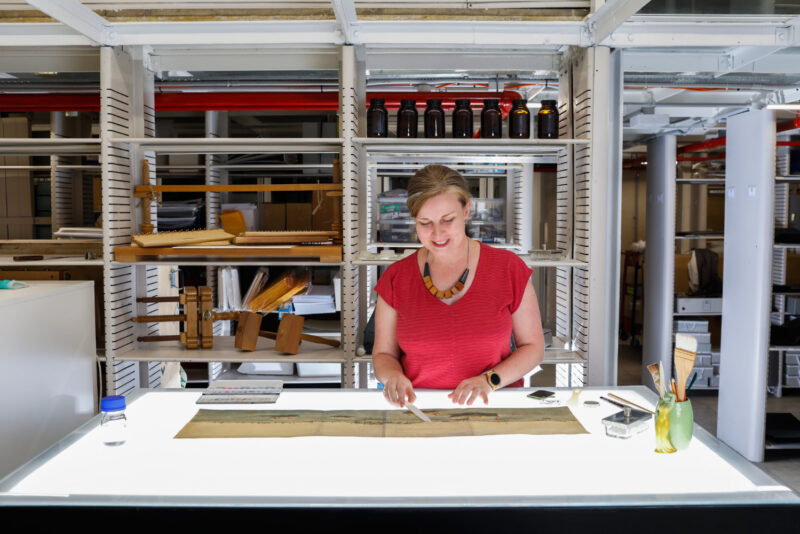
Cecilia Harvey treating watercolours for panaromas exhibition on a light table. © State Library of NSW. Image credit Joy Lai.
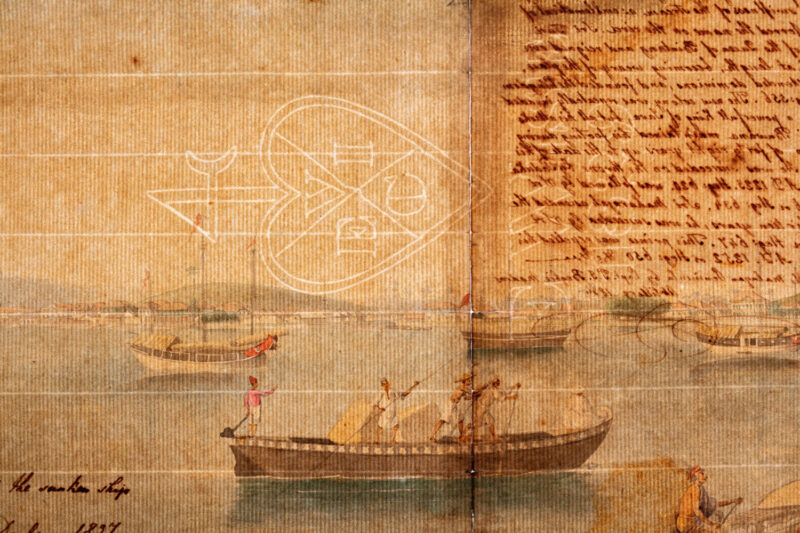
Watermarks found on panoroma work on paper – SAFE/XV99/SING/1.
© State Library of NSW. Image credit Joy Lai.
Queensland Art Gallery / Gallery of Modern Art (QAGOMA)
The Queensland Art Gallery / Gallery of Modern Art (QAGOMA) conservation team welcomed additional conservators in 2020 and 2021.
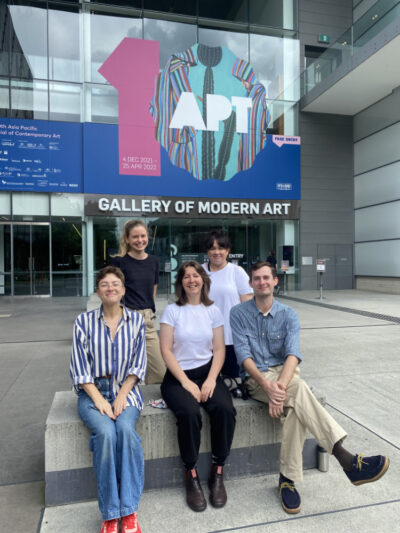
left to right: Ruby Awburn, Emily Kelleher, Margaret Barclay, Rebecca Negri, Dominic King. Image credit Simone Hines on behalf of the QAGOMA conservators.
In 2021, Dominic King accepted the role of Assistant Conservator, Works on Paper. He joins the wonderful Paper Conservation team on a contract basis, working alongside Kim Barrett, Samantha Shellard, and David Rousell. Dominic relocated from central Victoria where he was busy running his own conservation framing business throughout multiple COVID-19 lockdowns, following short contracts at both the NGV and AGNSW.
Ruby Awburn also joined QAGOMA on a contract basis as Assistant Conservator, Paintings, in late 2021. Ruby has been on quite the journey, relocating from Boston (USA) after a two – year position as the Richard I. Shader Fellow in Paintings Conservation at the Straus Centre for Conservation and Technical Studies, the Harvard Art Museums. Ruby has jumped at the chance to take on the role of AICCM Queensland Division President, following on from Rachel Spano (Senior Conservator at State Library of Queensland) who stepped down from the president role following a fantastic four years of leadership.
Ruby is working in paintings conservation with Gillian Osmond, Anne Carter and Emily Kelleher. Emily has been appointed to the role of Assistant Conservator, Paintings, on a permanent basis following the retirement of Mandy Smith, our long-term and much-missed Paintings Conservation Technician. Emily is a graduate of the University of Melbourne master’s course and has also been in the role of AICCM Queensland Division Secretary for the past few years.
In November 2021, Ruby and Gillian were fortunate to spend a morning with Queensland artist Joe Furlonger in his studio, discussing his approach to painting. Generously forthcoming, the exchange has helped our understanding of Furlonger’s material choices and the evolution of his practice. This interview was undertaken in preparation for an upcoming exhibition at the Queensland Art Gallery, and information gained will help inform current and longer-term approaches to the care and presentation of his paintings within the QAGOMA collection, as well as form the basis for a contribution to the exhibition catalogue.
Margaret Barclay recently relocated from Melbourne to take up an internship in Sculpture Conservation, with her first project being the conservation of bark paintings from the collection. Margaret is working with Catherine Collyer, Caro Toledo, Elizabeth Chapman and Elizabeth Thompson, with Michael Marendy assisting with textiles conservation. Gabriel Garde also volunteered with the sculpture conservators in 2021 to assist with the 10th Asia Pacific Triennial (APT10) exhibition preparations.
The Sculpture team saw a busy start to the year with ongoing APT10 installations due to the impact of COVID-19 on international logistics. A spectacular large-scale installation, with a delayed APT10 opening date, was The Fibrous Souls created by Kamruzzaman Shadhin and the Gidree Bawlee Foundation of Arts. Installed at the end of February, the artwork consists of woven jute, brass and clay pots suspended in embroidered shikas over the QAG Watermall. The installation proved to be an immense interdepartmental effort, from requiring various conservation treatments as the works arrived from their long journey to understanding the logistics of creating a temporary internal exhaust system to allow a diesel crane to operate safely within the gallery space. Weather emergencies and natural disasters also saw the team travel to regional galleries to assist with demounting of travelling exhibitions including artworks from the APT9 tour and Patricia Piccinini exhibitions. Despite the unhappy circumstances prompting travel this year, regional tours continue to provide a valuable opportunity to work with and listen to colleagues around the state.
Further exciting TBA news is that Catherine Collyer has begun work on the Time-Based Art AV Archive Project, streamlining QAGOMA’s TBA workflows in preparation for creating preview copies of TBA collection material online as part of the Digital Transformation Initiative.
Rebecca Negri relocated from the ACT to join us as Assistant Conservator Collection Online and is a current master’s student at the University of Canberra. Rebecca is working with Rhiannon Walker to assist a team of conservators, registrars and photographers with the mammoth undertaking of making the entire QAGOMA collection accessible online.
The Collection Online team has been powering through the photography of thousands of collection works – ensuring they are clean and correctly installed for their moment in front of the camera. Some older assemblage and installation works have required considerable sleuthing through acquisition notes and library archives to ensure they are installed as the artists intended. The team is taking this opportunity to update installation manuals and condition reports. As many of the framed works require deframing prior to photography, it has also been an opportunity to condition report works on paper and paintings and to rectify any issues with old mounts and frames.
Rob Zilli, Damian Buckley and Alex Forrest continue in Frame Conservation, producing exquisite custom stretchers and standard and custom frames, and restoring historic frames from the collection.
Amanda Pagliarino leads us all in her role as Head of Conservation, Registration and Imaging, dealing with a myriad issues from staffing and shipping logistics to planning for new offsite storage facilities.
Towards the end of 2021, all QAGOMA conservators were busy preparing and installing the APT10 exhibition. It has been a large undertaking across the two galleries: there are 69 projects from more than 150 artists from 30 countries, which feature a range of materials and techniques. Large scale installations to figurative paintings on copper, abstract paintings on tarps, photography and video works have all required condition reporting, preparation and problem-solving of installation procedures and requirements. While the pandemic delayed artwork shipments and timelines had to be adapted, the exhibition came together in time for its opening weekend on 4 December. The exhibition’s closing dates are staggered, with some spaces closing in April and others in June 2022.
The year 2022 started off with another full exhibition program, with changeovers in the Australian and International galleries, along with some great exhibitions coming up, which highlight Papua New Guinea collection works and other contemporary Australian and International works. The loan program is also ramping back up after COVID-19 related delays. Needless to say, we have been busy!
Further, we had a setback with the flooding of the Brisbane River in late February and early March 2022, which saw the Cultural Centre, including both QAG and GOMA closed for three weeks. Fortunately, the closures were warranted due to cleaning and safety checks required of carparks and low-lying adjacent areas and there was no water ingress or damage to collections. Our thoughts go to all those who have been impacted by the flooding and we applaud Museums and Galleries Queensland and AICCM joint programs such as ‘Zoom a Conservator’, which assist to put those affected by flooding in touch with conservators who can provide advice for the salvage of personal collection items during such distressing times.
Artlab Australia, Adelaide/Tarntanya
Projects
Artlab has been contracted by Adelaide Airport to re-locate the Vickers Vimy biplane currently located at Vickers Vimy Museum at the airport to its new location in the airport terminal. The aircraft is one of only two Vimys remaining in the world, and was flown to Australia from England in 1919– 20. To ensure preservation of this significant piece of aviation heritage, the aircraft will be moved to a new climate-controlled facility in a location that offers the public better access.
Ian Miles, senior metals conservator, and Fiona Hurel, objects conservator, have been preparing the aircraft. This has involved disassembling the wings and propeller, installing scaffolding around the plane and the four wings, and extensively wrapping the entire aircraft so it can be safely moved in the near future.
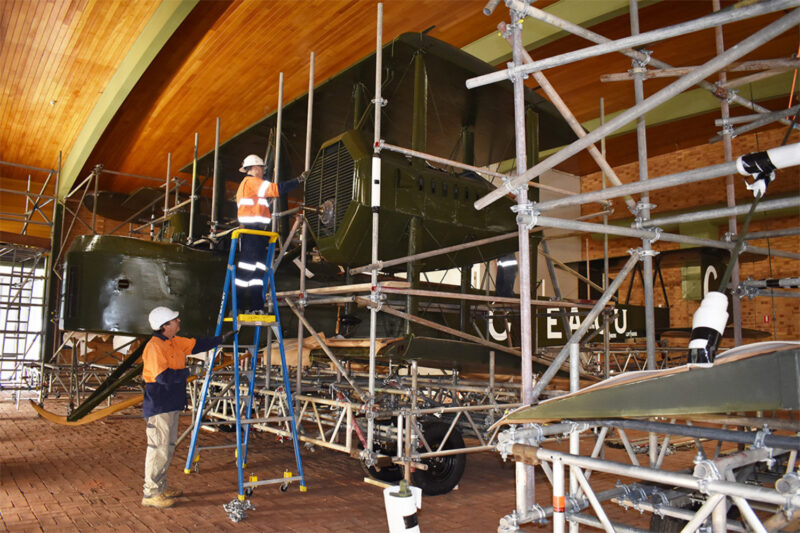
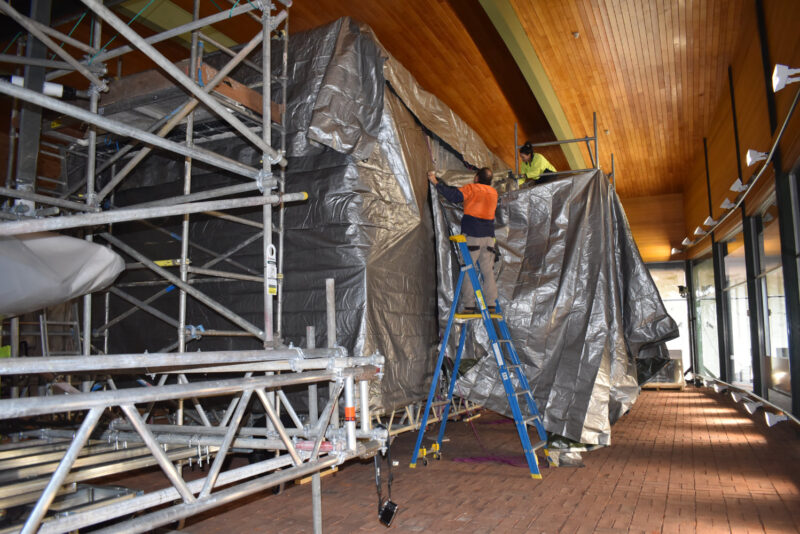
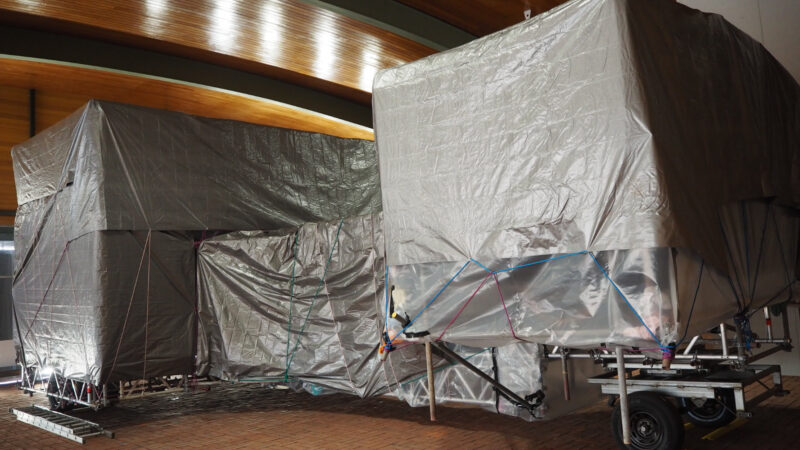
Artlab conservators assess and prepare the Vickers Vimy aircraft for re-location
Director, Andrew Durham, travelled with curators Luke Scholes and John Carty at the request of the Papunya Community to advise on the conservation of the mural paintings executed in 1971 on the walls of the Papunya school. The Wallaby Dreaming and Snake Dreaming murals, which were covered by an internal gyprock wall when the area became the school library, were revealed to Community members who performed a brief cleansing ceremony before the murals were re-covered with a new protective wall. The Community is now considering several options for the paintings’ future display and preservation.
Textiles
In January, Mary-Anne Gooden and Victoria Thomas from the textiles team assisted with the installation of Silhouettes: Fashion in the Shadow of HIV/AIDS at the David Roche Foundation. Curated by Skye Bartlett, the exhibition showcases works by 20th century designers who lost their lives due to AIDS-related illnesses, and in doing so highlights significant contributions to fashion and queer history. The show includes works from private and national collections, and the inclusion of Australian designers like Peter Tully, David McDiarmid and Brenton Heath-Kerr lends a local lens to the show’s international scope.
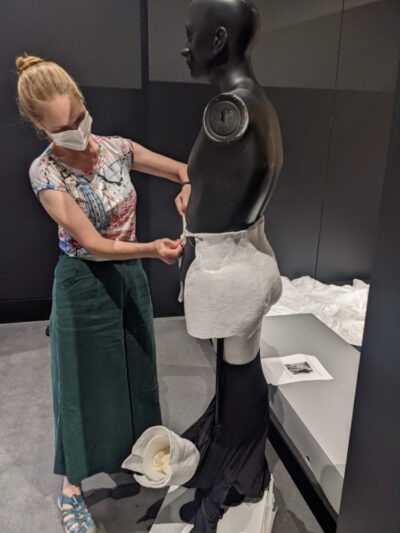
Mary-Anne dresses a mannequin for exhibition.
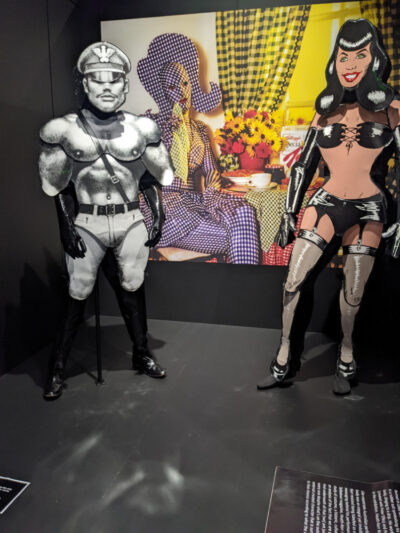
Brenton Heath Kerr’s ‘Tom’ and ‘Bettie Page’ costumes on display in Silhouettes: Fashion in the Shadow of HIV/AIDS at the David Roche Foundation. Underpinnings for these tricky costumes, which are comprised of paper-doll- style laminated prints that clip on to the front and back of the wearer, were expertly prepared by conservators at MAAS, who sent these through with the loaned items for Artlab’s conservators to assemble.
Arts Centre Melbourne (ACM)
As Melbourne has slowly emerged from COVID-19 lockdowns, ACM staff have returned on site for essential work with pandemic protections in place. It has been fantastic to be back working together and sharing the odd coffee outdoors. It hasn’t been quiet though!
In November we welcomed Bronwyn Cosgrove to the newly established role of Senior Textile Conservator. Bronwyn’s extensive experience in textile conservation and plastics research makes her a great addition to the team.
As the Melbourne Arts Precinct starts to take shape, Carmela Lonetti has been working on a project to temporarily relocate outdoor sculptures that will be impacted by construction. Under the direction of Samantha Hamilton, Head Collections, Preservation and Access, ACM is in the process of rejuvenating the Australian Performing Arts Collection spaces in Hamer Hall. In November, collection staff relocated objects to facilitate the commencement of building works and completed the relocation of collections from the off site store in Spotswood over summer.
Carmela Lonetti is involved with loan and acquisitions programs. Carmela liaised remotely with the on site team to complete remote condition reporting for Stranger Than Kindness: The Nick Cave Exhibition – Montreal, and is working on new acquisitions from Kylie Minogue.
Conservation staff have also lent their expertise to RISING: Melbourne. In May, five trams with designs by First Peoples artists will roll out of depots and onto Melbourne streets as a part of the RISING festival. Accompanying these five trams will be a recreation of Tram #829, painted by artist Lin Onus in 1991 Lin Onus Tram No 829_PROV 1991. Years of dust and grime needed to be removed to accurately photograph the designs for the wrapping used on modern trams. RISING stakeholder manager, Holly O’Connell, contacted Samantha Hamilton for advice on cleaning and after a short site visit ACM conservators Samantha Hamilton, Carmela Lonetti and Bronwyn Cosgrove advised that limiting water was imperative due to areas of flaking, corrosion, and exposed timber. ACM conservators arrived at the Newport tram depot bright and early to clean this iconic part of Melbourne’s heritage. RISING is very appreciative of ACM support, and we are looking forward to seeing the results on the streets shortly.
Recent treatments include the conservation of a Joan Sutherland costume from La Traviata, 1979. The badly shredded silk lace sleeves have been painstakingly conserved by freelance textile conservator Marion Parker. Bronwyn is currently working on a dance costume worn by Gertrud Bodenwieser in a solo dance, Asiatic Dances, in 1933. The costume includes hand-painted pantaloons and top with a metallic peaked collar. Rosemary Goodall, Materials Scientist at Melbourne Museum, has kindly undertaken FTIR and XRF analyses of materials to assist in treatment development.
Australian Centre for the Moving Image (ACMI)
Registration
Part of ACMI’s Registration team, consisting of Sarah Caldwell, Meg Taylor, Fiona Mowat and Holly Robbins, started the year completing the deinstallation of Walt Disney Archive’s exhibition Disney: The Magic of Animation, followed by the February conservation changeovers in ACMI’s The Story of the Moving Image exhibition. The changeovers also included the deinstallation and installation of our two main costume displays within the same exhibition. We embarked on the installation of six costumes from Hulu/Stan’s series The Great on loan from a production studio. Working with textiles conservator Marion Parker, the costumes were carefully dressed with conservation-grade custom underpinnings expertly prepared by costume specialist Laure Weir. ACMI also worked alongside milliner Chloe Simcox to prepare archival paper wigs to suit the scenes the characters wore with their costumes.
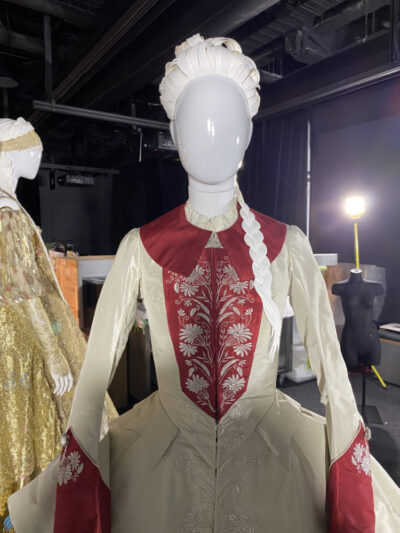
Catherine’s Red and Oyster War Dress and archival-grade paper wig from The Great Season 2, ACMI. Image credit Meg Taylor.
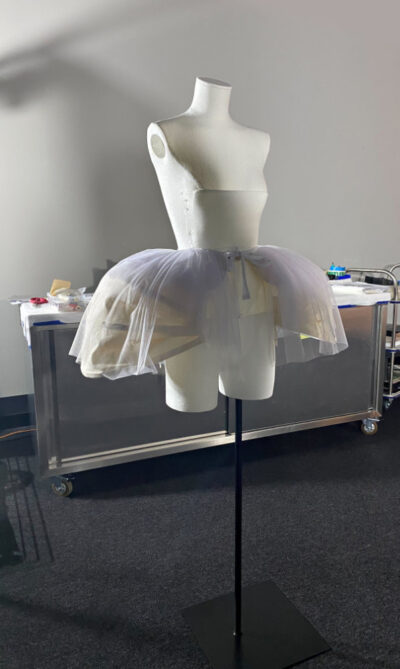
Conservation-grade underpinnings for The Great costumes at ACMI. Image credit Meg Taylor.
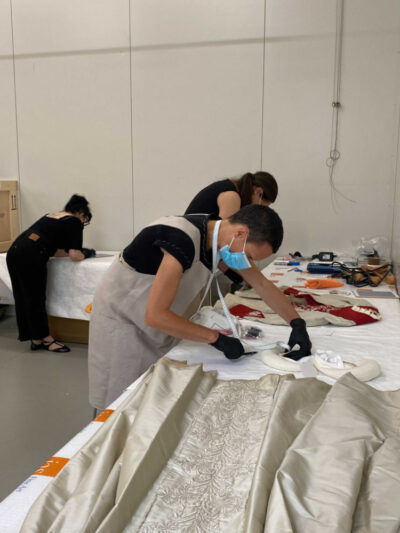
Laure Weir prepares conservation-grade underpinnings for The Great costumes, ACMI. Image credit Meg Taylor.
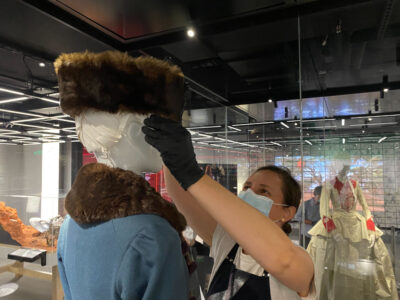
Marion Parker installs Catherine’s fur hat atop an archival grade paper wig for the Dacha costume from The Great Season 1 at ACMI. Image credit Meg Taylor.
Digitisation and film preservation
ACMI recently received a historically unique donation of home movies featuring Melbourne’s Moomba Festival. The 16mm films were made by aspiring filmmaker John Pallaris, who captured the extravagant float parades from 1955 to 1975. Stored beneath the family home in Ringwood, the films were thought to have been destroyed when the house was demolished. Fortunately, John’s grandson found the lost films, which Digital Preservation Technician Ben Abbott has physically and digitally preserved and made available to watch online.
Conference presentations
ACMI was represented at the ARC Conference 30 Something 2022, with Angela Petrow presenting ‘Down the Registration Rabbit Hole: Shifting an Exhibition from Temporary to International Touring’ and Meg Taylor and Candice Cranmer presenting on ACMI’s ‘Digital Condition Reporting App’ in Canberra in March. As part of the preservation work conducted under the two ARC grants in which ACMI is involved—Play it Again 2 and Archiving Australian Media Arts—ACMI representatives also spoke at the Born Digital Cultural Heritage conference on videogame and software preservation as well as time-based media conservation. As part of this project, Mar Cruz has been working with Cynde Moya (Swinburne University) and ACMI Creative Technologist Simon Loffler to bring 21 playable versions of classic Australian video games to life as part of the project’s collaboration with EaaSI, an online platform that allows for the configuration, sharing and access of emulated software environments.
Research projects
Seb Chan and Candice Cranmer contributed to the brilliant, recently published article by Gabi Arrigoni, Natalie Kane, Stephen McConnachie and Joel McKim, Preserving and sharing born-digital and hybrid objects from and across the National Collection, while our inaugural time-based media fellow, Jesse Dyer, completed his time with ACMI with a comprehensive study of ACMI’s software, VR and time-based collections. Read about some of this work in his article Conserving software: Unity, Macromedia Director, Max/MSP and time-based media in ACMI’s Collection
Collingwood Conservators’ Collective
Introducing: the Collingwood Conservators’ Collective, a group of conservation practitioners working collaboratively in a shared workspace in Collingwood, Melbourne. At the Collective we have Hanna Sandgren, Zora Sanders and Lucy Moore of Studio M., Robyn Ho and Eleanor Vallier of Care Of Studios, Madeleine Price of Objects Conservation Melbourne and Caroline Kyi of Kyi Conservation. We work individually and collectively on projects large and small, and are always happy to welcome conservators with a project who need a place to work – just get in touch via our new website: https://www.collingwoodconservatorscollective.com/
Recently in the studio
Studio M. has conducted lining treatments on some significant historical posters including a 3.5 x 2m advertisement for Bitter Campari by Leonetto Cappiello from the early 20th century. They are also treating a number of mid-century watercolour paintings, making use of washing techniques designed for the cleaning of works on paper with water-sensitive media.
c/o Studios have been collaborating with artist Jessie French to develop experimental research to inform her ongoing exploration into algae and agar-based bioplastics and their applications in art and design. In late March they will run the fourth and final workshop in the Women’s Art Register series ‘Preserve Your Story’, helping artists and collectors care for their collections.
Kyi Conservation has been undertaking conservation investigations at the Sale Law Courts to determine the historic decorative scheme with architect Biuro Ailtiri, and has been working with Maroondah City Council on conservation options for the Croydon Memorial Pool mural, painted by Niki Hassold and community members. Caroline has also conducted stabilisation works and environmental monitoring at the Royal Exhibition Building with conservation architects Conservation Studio, as well as investigations into original painted finishes at the Abbotsford Convent Gatehouse with heritage architect Nigel Lewis.
Marion Parker Textile Conservation has been working out of the studio cleaning and repairing the Busy Bee Quilt made in 1895– 6 for the Heidelberg Historical Society.
International Conservation Services (ICS) – Melbourne
It has been full steam ahead at ICS Melbourne in 2022. In February, ICS conservators Katie Smith, Kristine Allinson and Bruno Bell spent a week in Ballarat stabilising the head of a marble figure of Spring. The figure had been struck by a falling tree in the violent storms of October 2021. Whilst there, the team gave Spring a thorough treatment, which included the replacement of failing fills, consolidation and repointing. Katie also remodelled a floret in her crown, which had been lost in the same event.
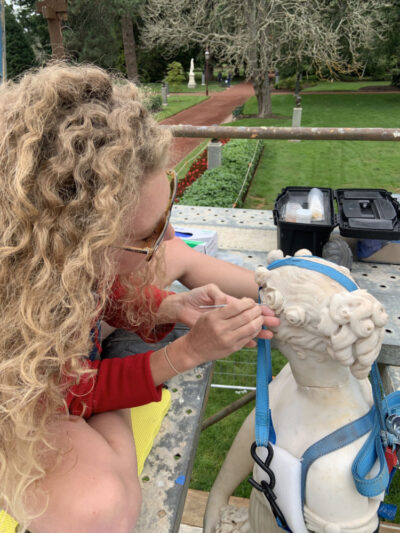
Katie Smith remodelling Spring’s lost floret.
Katie and Kristine travelled to Ararat to undertake paint sampling and materials testing on Ship Mural B at J-Ward Museum. This comes ahead of further works to conserve the mural later in the year. Pigment and binder analyses are currently underway at Sydney Analytical.
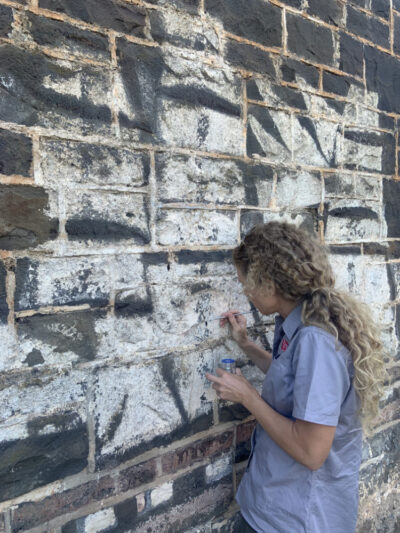
Katie testing materials on Ship Mural B
Bruno has been busily working on an archaeological assemblage from Rockbank Inn, whilst juggling the treatments of several small metal objects. He has also used his mount-making skills to fabricate a mount for a textile.
Additionally, ICS Melbourne has been utilising its walk-in freezer for preventive pest treatments. Recent freezing treatments include a collection of film costumes for ACMI. Alongside this, we have also managed to treat several small textiles and watercolours on paper.
National Gallery of Victoria (NGV)
General
The NGV Conservation Department farewelled Conservation Project Officer Jessica Lehmann who has taken up a new role as Exhibitions Coordinator at ACMI. We thank Jess for the amazing contribution she made to the team over the last three years. This included providing administrative support during changeable lockdown periods, developing and coordinating the NGV Conservation social media and microsites, and bringing colour and humour to the workplace. We wish her all the best in her new role.
Michael Varcoe-Cocks, Associate Director, Conservation, has been busy in his role on the steering committee of the design team for NGV-C. The successful architect for the new building, Angelo Candalepas and Associates, was announced in mid-March along with the concept design. The new build will feature dedicated contemporary art conservation studios, approx. 13,000m2 of dedicated gallery space and sustainable building design. NGV-C sits within a wider Melbourne Arts Precinct development, to create a unique open space that links key creative and cultural organisations in Southbank, including the Arts Centre. Michael is ensuring that collection care, conservation and exhibitions activities can continue and be adequately planned for around the next several years of build. MaryJo Lelyveld, Manager, Conservation, has been assisting Michael with this planning whilst ensuring the department meets general operational and exhibition activities.
We also welcome Manon Mikolaitis, Conservation Project Officer, to the team. Manon is supporting Michael with NGV-C and Melbourne Arts Precinct planning and, as a graduate of the Grimwade with a specialisation in TBM, will assist with auditing and preservation planning of the NGV TBM collection.
Paintings
With most staff members back on site and the NGV exhibitions schedule back in full swing, the paintings team has returned to its busy pre-COVID work program of major treatments, exhibitions and loans preparation, and ongoing research projects.
Raymonda Rajkowski has commenced treatment of a large, circular unstretched canvas from the early 1970s by the abstract artist Peter Upward (1932–84). This highly complex and large-scale treatment, involving structural repair, flattening, cleaning and surface integration, will be carried out over several stages. Raymonda has examined the structural complexities of treating circular canvases and has developed a methodology drawn on the valuable work of conservators at the Yale University Art Gallery. Raymonda has also been extensively involved in the exhibition preparation for Bark Ladies, an exhibition of large bark paintings by contemporary female Indigenous artists.
Raye Collins completed work on a new acquisition by Constance Stokes (1906–91), Portrait of a Woman in a Green Dress. This early work was painted in 1930 when the artist signed works using her maiden name, Parkin. During the treatment, Raye was able to gather invaluable insights into the artist and her practice through conversations with the artist’s daughter. Raye has prepared numerous other works for the upcoming NGV/NPG exhibition on Australian portraiture entitled Who Are You.
Caitlin Breare’s major treatment of Marie-Victoire Lemoine’s Napoleonic-era portrait A young woman leaning on the edge of a window was momentarily set aside to enable the cleaning and restoration of Hampstead Heath (c.1823), a painted sketch believed to be by John Constable. The painting has been the focus of a technical and stylistic examination by Caitlin and curator Laurie Benson and is now on display in the NGV galleries. Caitlin has also been extensively involved in the NGV / Getty Conservation Institute collaboration into monitoring response to environmental conditions using acoustic emissions technology.
Carl Villis has completed his treatment of El Greco’s Portrait of a cardinal (St. Bonaventure) (c.1600) and has continued the 17th-century Spanish theme by commencing work on a large canvas by the Sevillian painter Bartolomé Esteban Murillo, The Immaculate Conception (c.1645–55).
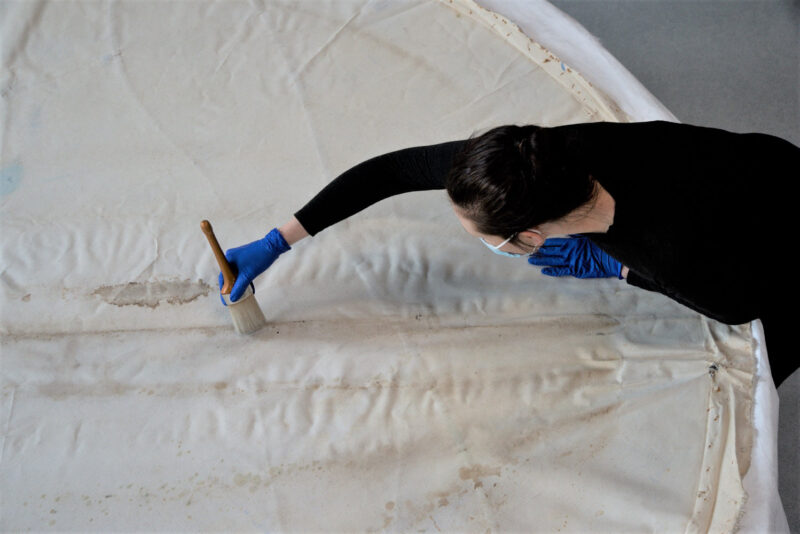
Raymonda undertaking large-scale treatment of a circular unstretched canvas by Peter Upward from the early 1970s. Image credit NGV Conservation Department
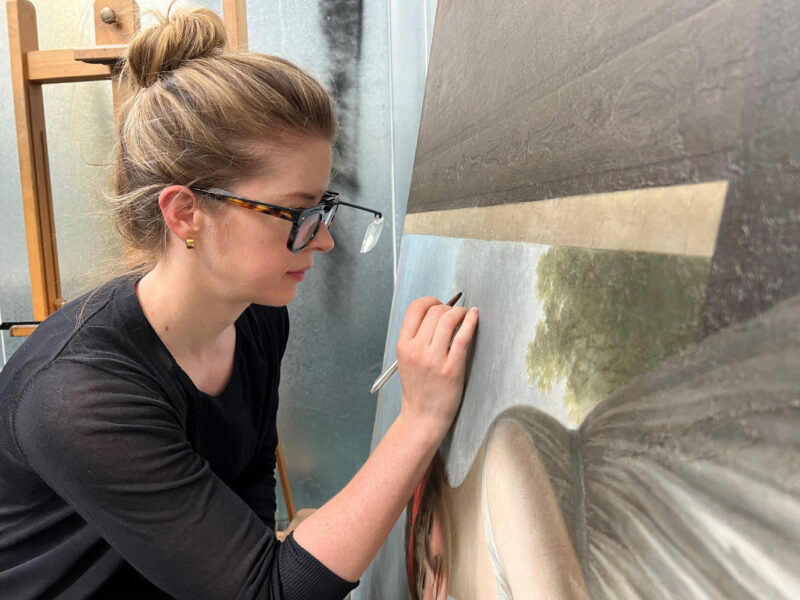
Caitlin working on her detailed treatment of Marie-Victoire Lemoine’s A young woman leaning on the edge of a window. Image credit NGV Conservation Department
Frames and Furniture
Suzi Shaw completed the treatment of a Korean cupboard decorated in geometric patterns of split bamboo, which have been nailed in place with … bamboo pins! Her mid-century-centric work continues, with the identification and subsequent removal (by specialists) of asbestos wiring in a Melbourne-made domestic lamp – a good reminder to keep your eye out for such hazards.
As well as forging on with metres of Modostuc fills, Bella Lipson-Smith has been recreating large areas of missing acanthus leaves for the 1871 frame for Charles Cope’s The Pilgrim Fathers: Departure of a Puritan Family for New England. Using photo-editing software, Bella created a digital mock-up of how the corners might look, manipulating images of existing leaf sections to fill in lost parts. This process demonstrated that the same mould was probably used to create different sections of the large leaf elements during the manufacture of the frame, and will assist in the recreation process.
Over the last few months, Holly McGowan-Jackson has been busy preparing frames for collection changeovers and the Queer and Who Are You exhibitions, with a focus on replacing missing parts and reducing distracting surface marks. Amongst the group of works was Charles Shannon’s Souvenir of van Dyck – Miss Kate Harwood in a Marmiton dress (1897) with its original frame by Chapman Brothers, London. The flat board frame featuring gilding directly on to oak had a large timber loss to the beading at the back edge. During the repair, the surrounding gilding was protected with low-molecular-weight resin coating, while a glue barrier layer was applied to the timber to be filled. A high-quality filled-epoxy system was chosen for the main part of the fill, with strength required due to its location on the working edge of the frame.
Objects
With a fantastic presence of objects, sculptures and installations in the NGV galleries, garden and foyer spaces, objects conservators Marika Strohschnieder, Di Whittle and Trude Ellingsen and mount makers are keeping busy. We have been preparing for Queer, Who Are You and several collection changeovers and foyer displays. The garden has also been a focus, drawing large crowds and keeping us on our toes. We are currently completing objects treatments and mounts for Transforming Worlds, the much-anticipated new display of Indigenous art, and Ron Mueck’s work MASS consisting of 100 skulls.
Paper and Photographs
In the Paper and Photographs Conservation studio, Louise Wilson and Ruth Shervington have been preparing Ngayakuk ngura – My Country (2019), a nine-part work on paper by late senior Amata artist Kunmanara (Wawiriya) Burton for display at NGVA from April 2022. Treatment has involved float mounting each part onto a paper-covered strainer and framing in an acrylic box so the works appear to hover on the wall when hung. In preparation for Transforming Worlds: Change and Tradition in Contemporary India, which opens at NGVI in April 2022, we have treated a painted Santal Jadupatua scroll from east India. Five metres in length with numerous edge losses, the scroll required extensive retouching and infilling. Fills were toned and fashioned from old Indian paper sourced from Jaipur, India.
Exhibitions
The Exhibitions team has welcomed Camielle Fitzmaurice, who has jumped in immediately to assist with the installation of the joint NGV and National Portrait Gallery exhibition Who Are You by making mounts and installing with magnets.
Now that Who Are You has been installed, Catherine Earley’s focus has moved beyond Easter to the deinstallation of the Chanel and Golden shells and the gentle mastery of Japanese lacquer exhibitions, the latter requiring re-acclimatisation of all the shells and lacquer to 60%RH before return to the lender’s museum. She has taken advantage of the new staffing to revise documentation including the ongoing gathering of statistics and tracking of individual exhibition preparation. Last month, along with colleagues, she also contributed to the NGVs International Day of Women and Girls in Science Instagram post.
Janelle Borig has had a busy two months deinstalling Camille Henrot: Is Today Tomorrow (for which she had collected and pressed an impressive array of flowers), the Maree Clarke and the Gascoigne-Connelly-Northey exhibitions and prepped and installed the Top Arts exhibition. She is now working on preparations for our Melbourne Winter Masterpiece exhibition The Picasso Century, sourced from the Centre Pompidou and the Musée National Picasso-Paris.
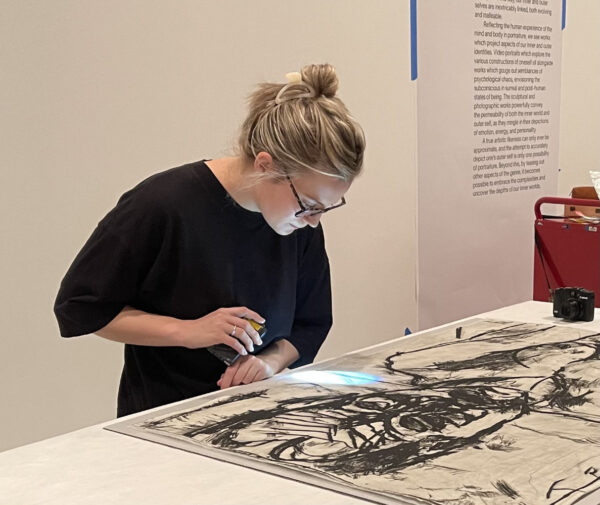
Camielle condition reporting paper works by Mike Parr before installing for Who Are You. Image credit NGV Conservation Department.
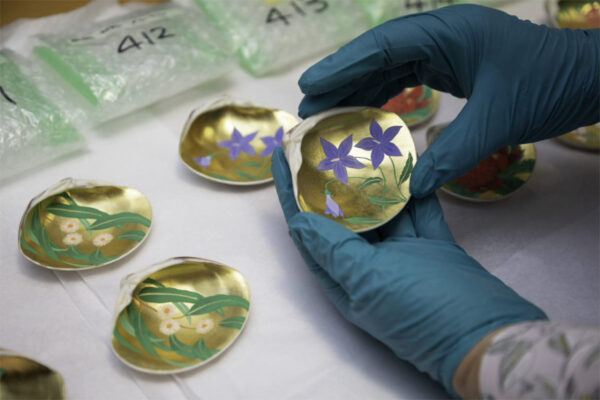
Catherine examining shells before photography to be displayed in Golden shells and the gentle mastery of Japanese lacquer. Image credit NGV Conservation Department.
Textiles
It’s been a busy start to the year for Skye Firth, Ellen Doyle and Kate Douglas in Textiles Conservation. Thirty mannequins were dressed for the Queer: Stories from the NGV collection exhibition as well as a number of costume changeovers at NGVI, which included a small tribute to Yves Saint Laurent. We have also been preparing a number of flat textiles for the Transforming Worlds changeover and are continuing our busy program to photograph costumes in the collection. In February, we were able to have a little bit of extra assistance in the lab with Didee Knight coming in to help with conservation and Vicki Car assisting Ellen with costume mounting. The lab has also completed pest treatments and condition assessments for a group of 60 Asian rugs and salt bags that are entering the collection.
Time has gone quickly and at the end of April we will be deinstalling Gabrielle Chanel: Fashion Manifesto. This is a complex undertaking, which means our ranks will swell with contract conservators, costume mounters and interstate and international couriers to condition report and pack these works for travel to Paris and Japan. It is yet to be announced, but we are starting to work busily towards another major fashion exhibition for the 2022/23 summer season. Stay tuned for an announcement from NGV soon.
Other news
In other important news, the NGV Conservation Department has recently upgraded its x-raying system, acquiring a new mobile digital x-ray unit. This new system was chosen as the best option for a modern, multi-campus art museum with a diverse collection like ours. It will enable us to rapidly expand the scope and scale of our x-raying capability, which for years has largely centred around the paintings collection but will now be readily available for objects, frames and furniture, and even fashion and textiles. Carl and Caitlin have gathered a lot of information relating to the current practice of digital radiography in art museums and are in the process of writing up their research as an aid to other museums and institutions that are considering upgrading to digital.
One Conservation
The team at One Conservation has been busy this summer, travelling up and down the country with all sorts of interesting and exciting conservation projects. From our home bases in Sydney and Melbourne, we’ve been lucky to venture as far as Caloundra, Port Macquarie and even Antarctica!
After a big year in 2021, Karina Acton forsook a well-earned Christmas holiday to hop aboard the French icebreaker FNS L’Astrolabe with the rest of the amazing team from the Mawson’s Hut Foundation and head to the far reaches of Antarctica. While there she got to remove six years’ worth of ice from the hut, assist with repairs to the transit hut, contribute to the longstanding monitoring program and treat some of the incredible items left behind by Mawson and his team.
Back in Melbourne, Frances Paterson has been working on a collection assessment for the Monash University Library. This project is a comprehensive investigation of the Library’s rare, unique and significant collections and will provide the University with an action plan for the ongoing care and preservation of its Special Collections. This has been one of those exceptional opportunities for a private conservator to work collaboratively with key collections staff and deep dive into the Library’s inner workings – an amazing project we’ve been privileged to be a part of.
State Library Victoria
Social news
Collection Care’s adventure through the alphabet continues with our popular A–Z series on the Library’s social media channels. Each fortnight, a different Collection Care activity or material is showcased. Most recently we posted about maps. Jessye Wdowin-McGregor, Preservation Technician, wrote a post highlighting a few of the over 110,000 maps in the collection. The post also tied in with the recent celebration of a significant milestone at the Library, the digitisation of over 30,000 maps and plans! Look out for upcoming posts in the series: N is for Newspapers, and O is for Old repairs.
Staff news
At the end of 2021, we bade farewell to the inimitable Jarno Coone, Senior Conservation Technician, who has decided to embark on a career change, outdoors and closer to home. More recently, we welcomed Jo Crabbe, Preservation Technician, to the Collection Care team until the end of June. Already a seasoned Library staff member, we were able to recruit her to assist with some collection rehousing projects. Jo is working on manuscript paper and glass plate collections and will soon start on a large photographic archive.
Professional
Albertine Hamilton, Conservator, Paper, was successful in gaining a place in the Color on Paper training course run by the Getty Foundation Paper Project. Designed for mid-career conservators, and limited to 12 places globally, this training program brings together conservators and collection specialists from across the world. The course covers the conservation, materiality, function and meaning of works of art on paper prior to 1900 CE, through the lens of colour. The 12-month program consists of six virtual workshops run through 2022 and a week-long residency in Los Angeles in early 2023. All costs including accommodation and travel are covered by the Getty Foundation. Congratulations Alby!
In February, Amanda Wild, Senior Conservator, Exhibitions & Loans, attended the 2022 IADA Online Symposium, Show it and Save it: Exploring the compromises between exhibition and preservation. Also in February, Kate Holloway, Preservation Manager, and Leah Williams, Preservation Technician, attended a two-session virtual course facilitated by International Academic Projects (UK) on Integrated Pest Management, discussing common insect pests and behavior, program strategies and treatments. It was timely, as we were about to induct a new pest control technician at our offsite stores and could look at issues with fresh eyes.
In other news, Collection Care has been conducting tours through the Quarantine Room, Preservation Studio and Conservation Lab for new Library staff who commenced employment during the lockdowns of 2020–21. Over 100 staff joined the Library during this time, and many have only just recently returned to (or commenced!) working on site. The tours have been very popular and a great opportunity to meet new colleagues face to face, introducing our work and spaces to those less familiar with how the Library’s collection is cared for.
Preservation projects
Having returned to onsite work in November, we’re back in amongst our collections again, which is a great feeling.
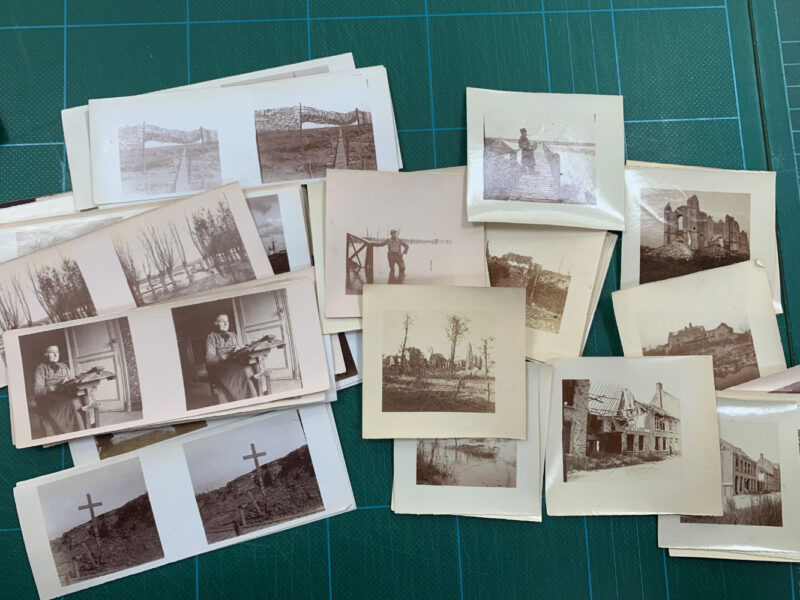
‘Secret’ photographs from Occupied Belgium from uncatalogued collection. Image credit Kate Holloway.
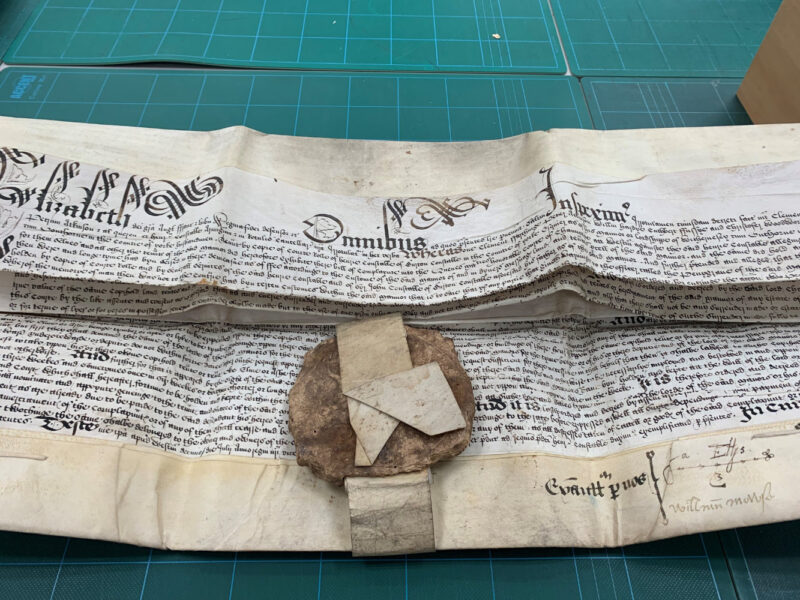
16th century parchment – requiring treatment & cataloguing. Image credit Kate Holloway.
Preparation of Victorian newspapers for digitisation has recommenced, which includes slight humidification of very brittle pages with heavy folds. The continuing determination and dedication of preservation technicians Jessye Wdowin-McGregor, Christine Mizzi and Josh Cassidy will mean these 2019–20 digitisation titles will be completed this year.
Work in Quarantine has also resumed, with a significant two-year backlog of collections still flowing in for assessment and treatment. A small Preservation Quarantine Team was established at the end of 2021 to address the existing collections and, moving forward, to efficiently manage the ongoing collection deliveries.
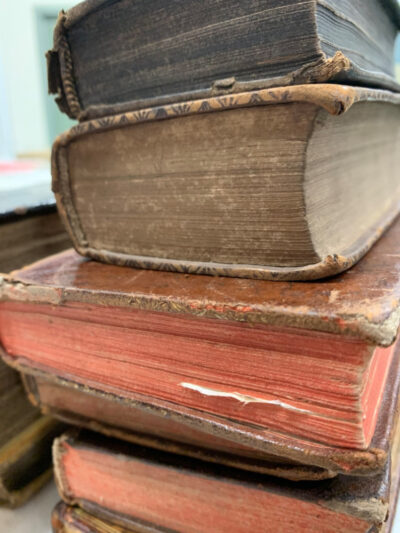
Monograph material awaiting Quarantine assessment. Image credit Kate Holloway.
In January, staff from across Collection Care responded to a significant leak in one of our collection stores, the result of an intensive downpour that hit the city. Response and Recovery teams along with assistance from our Property staff worked to remove and treat collection items affected by this event. A significant number of books were removed and treated. A batch of very wet books was frozen and they are now being freeze-dried by an external provider. It will be interesting to see the results on this treatment.
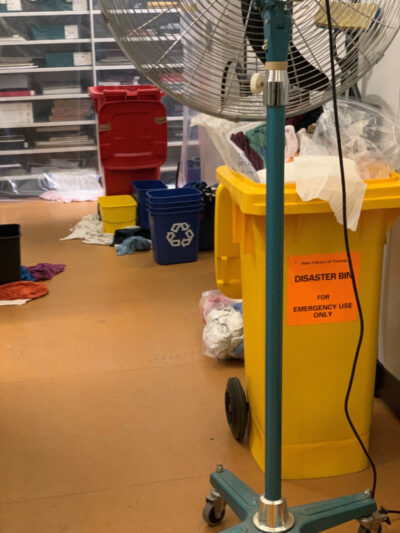
Disaster response equipment in action. Image credit Kate Holloway.
Conservation projects
The paper conservators are close to completing treatment of the Coppin Theatre playbills. This project commenced in 2016 and, while progress was waylaid by several lockdowns, to date we have spent over 1000 hours working on the collection. This included many hours spent on six oversized posters, the largest measuring over 2 x 2 metres. With only two playbills left to complete, the end is in sight! Of course, as one project winds down, another begins – the team will soon commence work on a sizeable collection of architectural drawings of St Paul’s Cathedral by the architect William Butterfield, which will also be a key feature of the Library’s Annual Appeal for 2022.
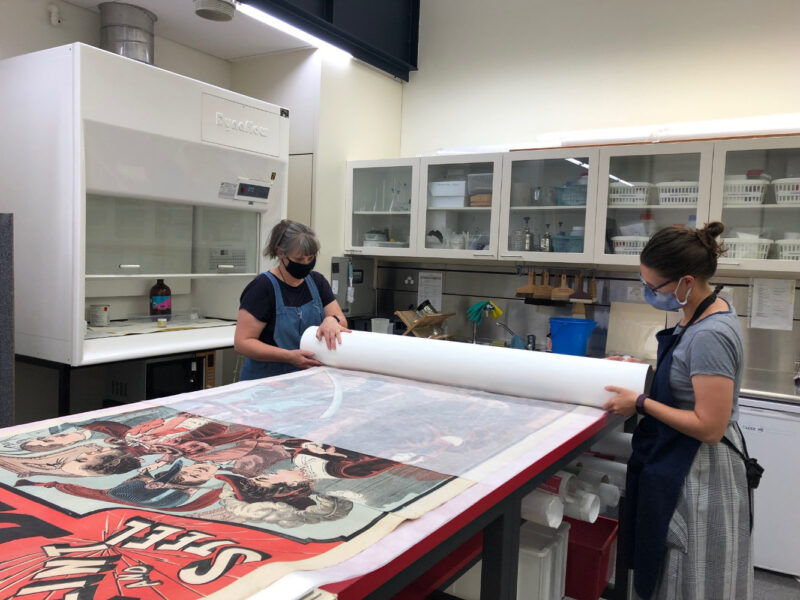
Marika Kocsis and Emily Keppel rolling an oversized Coppin Theatre poster. Image credit Albertine Hamilton.
Marika Kocsis, Senior Conservator, Paper, shared what she learnt from the 2021 IAP Virtual Seminar, Nanocellulose Films in Conservation, with a team discussion and practical demonstration that involved preparing the nanocellulose mixture, determining drying times, and handling the nanocellulose films. We’re excited by the possibilities presented by this new material and are keen to explore further, such as creating composite mixtures with different adhesives and potential treatment applications, especially on transparent papers. In particular, we have several original Dorothy Wall illustrations for the Blinky Bill series done on tracing paper in need of stabilisation and are keen to test nanocellulose as a potential repair paper. Jessica McElhinney, Conservator, Paper, is flattening and repairing the Grounds, Romberg & Boyd architectural plans as required, and recently outlined her process for making heat-set tissue to newer members of the Conservation team, Emily Keppel, Conservator, Paper, and Bonnie Hearn, Conservator, Books.
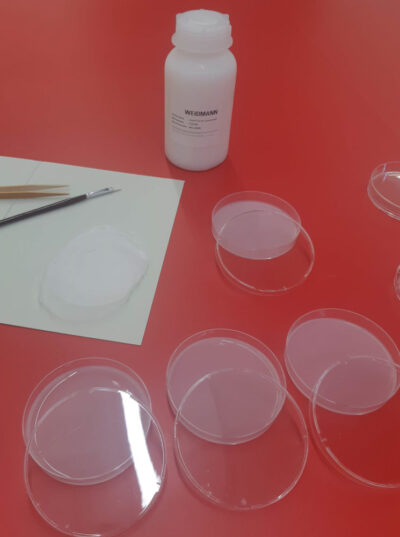
Preparing nanocellulose films. Image credit Emily Keppel.
The book conservators have been revisiting and refining leather underback techniques and making good use of our newly acquired knife-sharpening machine (and developing a procedure), as demonstrated by Katrina Ben, Senior Conservator, Books.
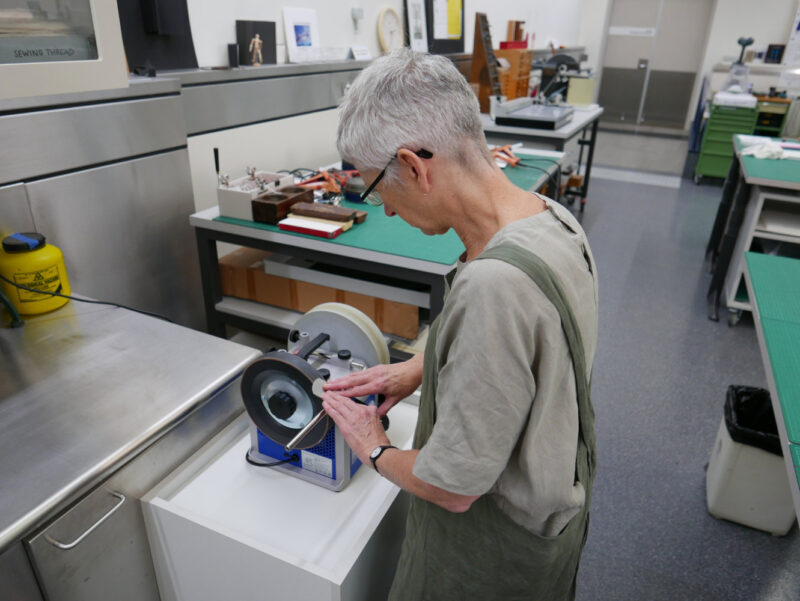
Katrina Ben honing a leather paring knife on the Tormek sharpening machine. Image credit Helen McPherson.
Bonnie Hearn, Conservator, Books, has been working closely with the Technology staff and Leica representatives to update our procedures and software for microscope imaging. This will create new possibilities for more detailed technical examination and conservation treatment documentation. Bonnie has been using the new set up to examine vulnerable miniature paintings of selected Persian and Mughal Indian manuscripts and has commenced stabilisation treatment, trialling isinglass applied with a fine brush under magnification.
Exhibitions and loans
Our next major Victoria Gallery exhibition, Handmade Universe, is scheduled to open in early June 2022. Centred around Sarah Spencer’s extraordinary oversized machine-knitted interactive star map, Stargazing, the exhibition will explore the intersection of craft and technology, with a particular focus on women’s stories. It will feature a selection of Library collection items, commissioned artworks, and loans from cultural institutions and private lenders.
Katy Glen, Conservator, Photographs, has been assessing and treating several photographs for external loan to the Jewish Museum of Australia for the upcoming exhibition HELMUT NEWTON: In Focus (29 April 2022 – 29 January 2023).
The book conservators reawakened World of the Book, which opened to the public on 27 January. This exhibition, showcasing books from the Library’s collection, had only just been installed when Lockdown 6 was announced in Melbourne back in August 2021.
Finally, in February 2022, we bade farewell to Changing Face of Victoria, a staple exhibition in the Dome Galleries since opening in November 2004. It showcased numerous collection gems (including the Ned Kelly armour, the Ludwig Becker sketchbook and Tommy McCrae drawings) and told many important stories about Melbourne and Victoria. Over 16 years, the Conservation team has treated, prepared, and installed thousands of artworks, posters, books, and objects for this exhibition.